Ministerial Transition 2025
Welcome letter
Dear Minister,
On behalf of our entire team, we would like to take this opportunity to welcome and congratulate you on your recent appointment as the Minister responsible for Shared Services Canada (SSC). We look forward to working with you to implement the government’s agenda, including driving efficiency through the use of artificial intelligence (AI) and automation, accelerating service delivery improvements, enabling digital transformation through the adoption of innovative technologies, and strengthening Canada’s digital sovereignty.
While SSC is not widely known, we are one of the single largest consumers of information technology (IT) goods and services in the North American market, and we work collaboratively with industry partners to deliver our services. In the past, SSC’s mandate was focused on consolidating and modernizing IT infrastructure. While this work is ongoing, SSC is now also delivering the foundational digital services necessary for the Government of Canada (GC) to recover its position globally as a leader in digital government.
SSC is essential to the operations of government. We are present wherever the GC operates — spanning about 4,000 locations across Canada and around the world. SSC has dedicated teams that work around the clock, 24 hours a day, 7 days a week. Our work is guided by One SSC to Deliver Digital Together which centres on the evolution to a fully integrated client-centric organization. SSC provides connectivity, cybersecurity, hosting and digital services to enable public servants, military and policing personnel across Canada and around the world to deliver programs and services to Canadians.
While maintaining IT infrastructure and ensuring cyber resilience remain core priorities, SSC is also focused on:
- delivering on GC’s ambitious Application Hosting Strategy to provide secure, reliable, cost-efficient options for critical business applications;
- providing modern, enterprise-wide business applications;
- prototyping an enterprise approach to all end-user technology; and
- building tools for the GC that are secure, cutting edge, and that protect the data Canadians entrust to government.
Since our creation as a department, SSC has been at the forefront of the GC’s digital transformation, increasing the reliability of government technology and decreasing associate costs, all while consumption of our services has skyrocketed. Our work has provided the GC with one of the most sophisticated cyber defences in the world, which we deliver alongside the Canadian Centre for Cyber Security, and has blocked over 6 trillion malicious cyber activities.
While SSC is providing tangible results, there remains significant room to do better. For example, at its inception SSC was transferred a multitude of systems and networks from 42 partner departments. Most were aging or completely outdated, lacked interoperability with modern infrastructure. Over the years, SSC has expended considerable effort to consolidate this infrastructure and invest in repairing and replacing critical platforms, as well as in standardizing the core enterprise services that we now provide to 45 partners and 93 client departments. By shifting the business model from siloed and and decentralized, to a government-wide approach, SSC has reduced costs, boosted reliability and strengthened security. While this work continues, our single greatest risk remains the unhealthy applications within the GC, as noted by the Auditor General of Canada.
In 2023-24, SSC procured $4.3 billion of goods and services on behalf of departments and agencies including SSC itself. Through this, SSC leveraged its purchasing power to increase access to economic opportunities for Canadian businesses, small and medium sized enterprises and Indigenous-owned businesses. We are particularly proud to have exceeded the government target of 5 percent Indigenous procurement, and we are advancing work to diversify suppliers and strengthen Canada’s digital sovereignty.
Looking ahead, SSC will continue to modernize costly and vulnerable legacy systems; advance reliable, secure and integrated enterprise services; and decrease vendor concentration through diversification efforts. We will also continue to implement cost-saving measures to ensure public dollars are spent as effectively as possible, allowing for reinvestment within SSC in key areas, including accelerating AI adoption, eliminating duplication, and phasing out outdated and costly legacy applications across the GC.
We look forward to building a collaborative and productive relationship with you and your team. Our management team is available, at your convenience, to brief you on all departmental business.
Minister, we wish you the best. Congratulations once again.
Sincerely,
Scott Jones
President, Shared Services Canada
Raj Thuppal
Executive Vice-President, Shared Services Canada
Departmental overview
Shared Services Canada (SSC) was created in 2011 as the common digital service provider for the Government of Canada (GC). Its mandate is to consolidate, modernize and secure the information technology (IT) infrastructure that supports departments and agencies, enabling service delivery to Canadians at home and abroad. Moving from an outdated and decentralized IT approach to a government-wide approach has created economies of scale and resulted in secure, reliable and cost-effective service delivery for Canadians.
While SSC supports traditional office work, it also enables partners in frontline service delivery, national security and defence operations. SSC services support border guards, scientists, park rangers, food inspectors, lighthouse keepers and our Canadians in uniform. SSC proudly supports over 400,000 GC workers (including employees, military personnel, police officers and more) and over 145 organizations.
SSC provides IT services, including email, networks, data centres and employee tools in 4 areas: digital services, hosting, cyber security and connectivity.

Digital services
SSC provides employees a common digital experience with a standardized bundle of tools anywhere, anytime, from any GC device, with seamless transitions between roles within the public service. This enterprise approach helps reduce costs and security risks, and provides tools that underpin transformational changes to GC operations.
SSC has migrated 38 of 45 partner departments from isolated email systems to a unified suite of collaboration tools hosted on a cloud-based platform, with better functionality, security and reliability—a considerable improvement from the fragmented legacy systems it replaced. As part of this work, SSC leveraged the GC’s buying power to negotiate a competitive enterprise service agreement that locked in rates over a lengthy term to centrally support all departments with Microsoft 365.
SSC delivers IT solutions for over 220 contact centres that manage citizen enquiries on a wide range of programs, including Employment Insurance, the Canada Pension Plan and questions related to taxes. It also offers IT solutions to smaller centres, such as the Non-Insured Health Benefits program for Indigenous Services Canada and Marine Safety and Security for Transport Canada. SSC manages the technical solutions that enable partners to leverage contact centre capabilities such as voice, chat, email, call-back and self-serve options, as well as support for artificial intelligence (AI) chatbots. SSC actively ensures that partner and client departments have access to modern and sustainable solutions that enable the adoption of emerging technologies.
SSC oversees the end-to-end management of 219,000 smartphone devices for 45 partners and 6 client departments. Through bulk purchasing of smartphones, preferred rates have been secured, resulting in $20 million in annual savings for the GC. SSC is introducing an enterprise softphone service that is significantly reducing the reliance on outdated fixed telephony lines and mobile devices.


Hosting
Hosting refers to the infrastructure necessary for departments and agencies to store data, run applications and leverage high-performance computing in order to deliver services to Canadians. SSC is working to create a reliable, scalable, secure, sovereign and cost-effective hosting ecosystem. SSC is achieving this goal through a hybrid hosting model, which combines cloud services and traditional data centres to optimize performance, reduce costs and provide flexible solutions to respond to the evolving digital environment.
SSC hosting offers both cloud solutions—with public, private and hybrid options—and its own Enterprise Data Centres (EDC). While cloud solutions are secure, scalable and flexible, EDCsensure high availability, efficiency and security. Both options allow departments and agencies to rapidly deploy and manage digital services while optimizing costs.
To allow partners to focus on running their own business applications, SSC’s hosting services provide the core platform, application, data and software services. This includes managing operating systems, databases, platforms and storage.
Example: Booth Street migration
The legacy data centre on Booth Street in Ottawa was a key facility for Natural Resources Canada (NRCan), housing data and applications on natural disasters like floods, wildfires and earthquakes. However, its older systems continued to have operational challenges: the servers were nearing capacity and failing due to overheating and aging data centre infrastructure. SSC worked with NRCan to move its systems to a modern SSC EDC. The move to an EDC prevented an average of 20 critical incidents annually, eliminated the need for one to two days of annual maintenance shutdowns, saved more than $55 million in operating costs and reclaimed $31.6 million in real property space. Modernization has reduced operational costs while making government data safer and ensuring that critical services can be delivered to Canadians.
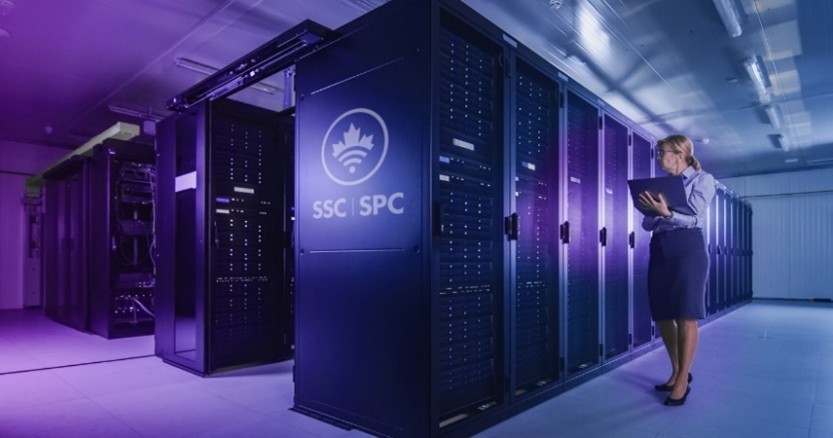

Cyber security
SSC provides the infrastructure and modern commercial defences that protect the GC from a wide range of cyber attacks. SSC’s strong cyber security defences are key to protecting the GC’s ability to deliver services to Canadians. SSC has multiple layers of cyber security defences such as firewalls, network defences, anti-denial of service defences, anti-virus, anti-malware, as well as identification and authentication tools and services. It also reduces vulnerabilities by standardizing and consolidating IT across the GC.
The Canadian Centre for Cyber Security (CCCS), part of the Communications Security Establishment (CSE), provides defensive capabilities that are not currently available commercially, adding an additional layer of defence unique to the GC. Together, SSC and CSE provide the most sophisticated cyber defence available to any entity.
Cyber security is a shared responsibility between SSC, CSE, the Treasury Board of Canada Secretariat (TBS) and partner organizations. The aforementioned organizations provide advice, guidance, oversight and direction to address GC-wide security initiatives. They coordinate operational cyber security activities and manage cyber security risks at the enterprise level, including how cyber security data and threat intelligence is shared and actioned across government.


Connectivity
SSC delivers modern connectivity services—network infrastructure and teleconferencing—for a wide range of government facilities located from coast to coast to coast. SSC supports about 4,000 locations, including offices, science labs, Royal Canadian Mounted Police (RCMP) detachments, border outposts and nursing stations. SSC also works closely with Global Affairs Canada and the Department of National Defence to support their facilities within Canada and around the world.
In recent years, SSC accelerated bandwidth improvements, upgraded network performance and significantly increased secure remote access capacity. SSC has increased the overall bandwidth available by a factor of 10 and reduced the cost of access by approximately half to meet a surge in demand and ensure smoother, more reliable communication.
SSC has introduced a whole-of-building approach to installing enterprise Wi-Fi, in order to quickly scale up and generate significant cost reductions. These efforts enhanced productivity and reduced the number of critical network service incidents.
To provide high-speed connections in isolated locations, SSC awarded contracts for Low Earth Orbit (LEO) satellite services, on an as-and-when-required basis.
Example: Geographically remote workplaces
In support of the RCMP, SSC has deployed modern high-speed satellite services to improve radio communication in the most isolated areas of the country and to enable the RCMP body-worn camera program.

SSC operates a private secure network connecting critical government facilities, such as data centres and telecommunications and network hubs. SSC established GC Networks Hubs across the country, providing the external network connectivity between the GC network, the Internet and cloud service providers. Distributing hubs across the country speeds up the network for users in the regions and improves service availability and redundancy, as it serves as an additional location to route network traffic should another hub experience a service disruption.


Key risks
Vendor lock-in and rising costs
Vendor lock-in is the result of an increased reliance on a single provider’s product or service. It limits flexibility and creates a challenging environment to negotiate better terms.
Migrating to other platforms is also technically demanding and resource-intensive, further complicating flexibility and cost control efforts. However, managing multiple providers and their associated components may not always be more cost-effective than having a single provider. SSC balances these considerations on a case-by-case basis.
IT procurement
Shifting market dynamics, including consolidation and vendor lock-in, could result in delayed contract awards, higher costs, reduced flexibility, and significant challenges for SSC in transitioning to alternative providers or replicating solutions internally.
Incentives and cost to modernize
Misalignment of incentives across GC departments to prioritize the replacement of legacy infrastructure and unequal cost-sharing and commitment to modernization may hinder the pace of digital transformation.
Emerging technologies
Adoption of emerging technologies (most notably AI) may increase technological vulnerabilities and interoperability issues, increase demand on infrastructure, hinder scalability challenges, and lead to higher costs.
Fiscal environment
A changing fiscal environment may impact revenues and jeopardize planned investments and modernization projects.
Cost overrun
The combination of inflationary pressures and rising IT infrastructure costs, particularly in cloud services and hardware, can threaten the sustainability of critical digital transformation initiatives. Volatility in public cloud pricing and an increased reliance on cloud technologies could impact budgets and reduce flexibility in scaling operations efficiently.
Cyber security
More frequent and sophisticated cyber security attacks, as well as the adoption of new technologies, may lead to the vulnerability of SSC’s security posture, which may impact the integrity and availability of information and access of services to Canadians.
Reputation for service delivery
Increasing demand for digital services and their timely delivery, coupled with SSC’s efforts to increase transparency and predictability for IT services, may impact service delivery and SSC’s reputation.
IT skills and innovation constraints
The rapidly changing IT environment will require employees to develop new and different skillsets. Without the upskilling of SSC’s current workforce, there will be knowledge gaps that could lead to delays in innovation and ability to meet partner and client needs in a timely and cost-effective manner.

Key opportunities
Digital sovereignty
SSC is in an important position to support digital sovereignty within the public service, given its unique role of securing government data and maintaining control over digital assets to protect Canada’s interests. Digital sovereignty refers to a country’s ability to govern its own data, infrastructure and technology without external dependencies or undue influence.
Several key GC policies reinforce digital sovereignty, ensuring data security and technological independence. For example, the Policy on Service and Digital integrates privacy and data residency requirements, prioritizing the use of computing facilities within Canada or government-managed premises abroad for handling sensitive and classified information. Additionally, SSC’s EDCs are strategically located within Canada and operate on Canadian-owned assets, ensuring compliance with national data protection standards.
To further strengthen sovereignty, SSC has been actively collaborating to advance an IT Diversification Strategy. This initiative aims to increase vendor diversity and improve the ability of the GC to negotiate pricing. It can also be used to decrease reliance on foreign technologies, foster a more sovereign IT ecosystem, and promote Canadian-made solutions.
However, given the relative size of Canada’s IT sector and the penetration of US technology vendors globally, targeted support will be needed to scale Canadian IT capabilities to a level necessary to respond to government requirements. This is particularly the case in the cloud computing space, which is dominated by Amazon Web Services, Google Cloud and Microsoft Azure. That said, SSC is currently working with select Canadian cloud service providers to assess if these vendors can meet GC sovereign hosting requirements.
The GC has also made strategic investments in Canadian IT firms, such as the March 2025 announcement by Innovation, Science and Economic Development Canada (ISED) of up to $245 million into Cohere Inc., to further build and strengthen domestic compute capacity in Canada and support the development and scaling of AI capabilities.
As emerging technologies continue to evolve, SSC is committed to enhancing digital resilience by evaluating new approaches to cyber security, cloud adoption and supply chain integrity. By investing in domestic technology capabilities and reinforcing policies that safeguard critical infrastructure, SSC contributes to the long-term digital sovereignty of the GC.
GC Application Platform as a Service
SSC introduced GC Application Platform as a Service (GCaPaaS), a centrally managed cloud-based solution for standardized enterprise applications. By centrally managing the infrastructure, software tools and services, GCaPaaS makes it easier for partners to leverage and consume applications quickly. This structure provides a cost-effective way to provide common tools across the GC. SSC is working to identify new enterprise-wide applications that can be deployed to this hosting environment.
Example: Audit community
Previously, more than 1,000 GC employees used an audit management tool to manage audits and streamline their workflows. Each organization managed their own version of the tool, and each version was housed on aging infrastructure with specific maintenance needs. Using GCaPaaS to host a new replacement solution is expected to generate more than $66 million in savings over the next 5 years. Housed in the cloud and with its simplified support model, the new application is standardized to ensure consistency for all users.
Enterprise Desktop Service
Desktop computers and other digital tools (e.g., laptops, tablets) that employees use are currently managed by each partner independently. Building on the lessons learned from the common management of smartphones, SSC is developing an Enterprise Desktop Service (EDS) that would standardize desktop engineering, IT asset management and support services across the GC. The aim is to ensure all employees consistently have reliable, modern devices to do their jobs—tools that stay with them even if they transfer to another department. SSC would provide unified end-to-end support, asset management and procurement. This would reduce costs and provide a common digital experience. It would also reduce the significant barriers persons with disabilities face when changing jobs.
Softphone everywhere
Traditional fixed desk phones are becoming increasingly obsolete, as cloud-based solutions offer greater mobility with the same features as a traditional fixed line. A modern approach is softphones: software that allows the user to place and receive calls without a dedicated telephone device or plan. The adoption of a “softphone everywhere” approach will modernize communication infrastructure, enhance workforce mobility, and significantly reduce operational costs. As departments and agencies transition to mobile-ready environments, softphones provide a secure, scalable solution without requiring major capital investments. This approach ensures interoperable, standardized and centrally managed communications at a low cost to the GC.
Key facts
Timeline
Shared Services Canada (SSC) was established to standardize and consolidate certain administrative services supporting Government of Canada (GC) institutions for the purpose of enabling the effective and cost-efficient provisioning of information technology (IT) services.
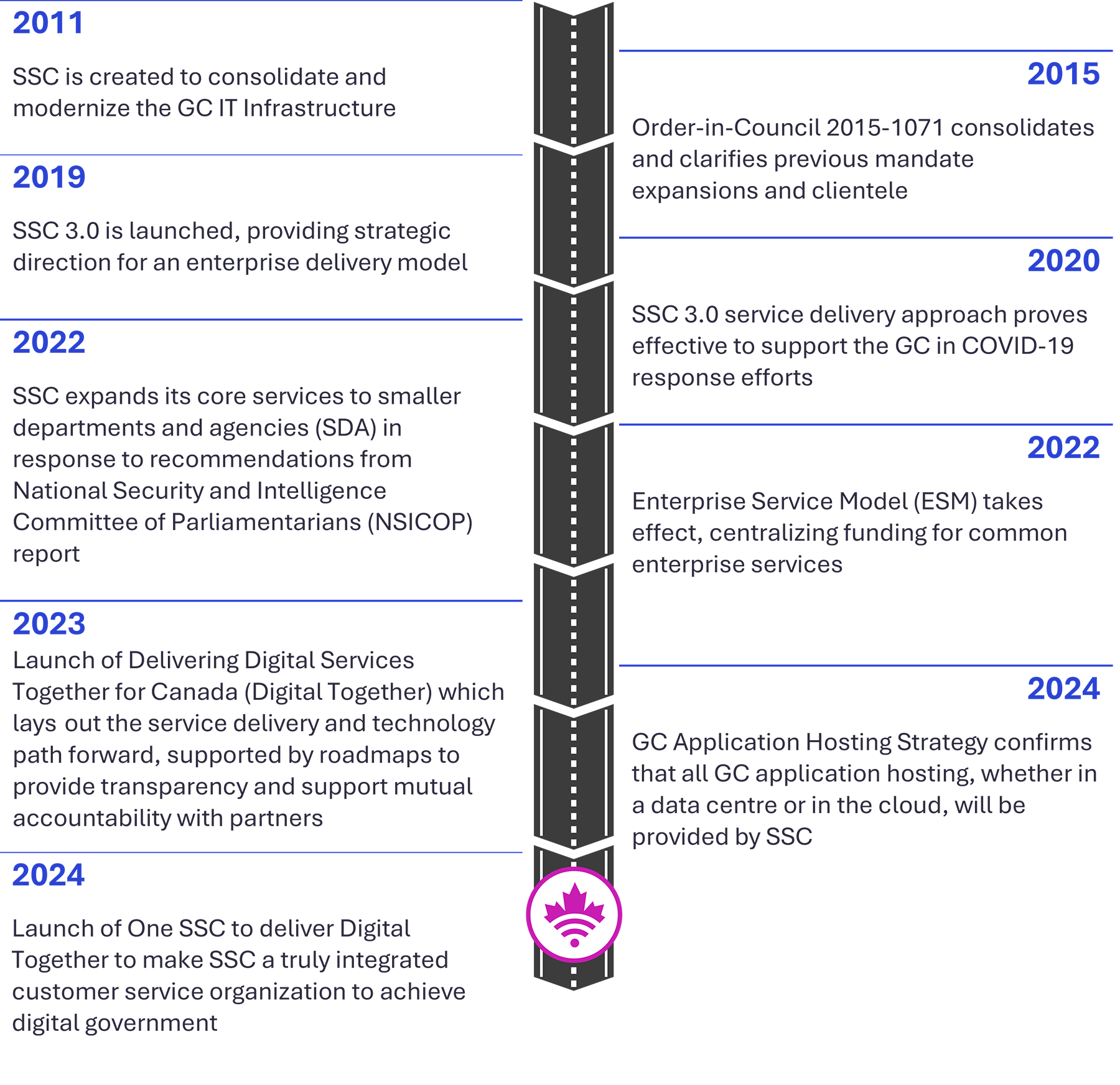
Timeline - Text version
- 2011
-
SSC is created to consolidate and modernize the GC IT Infrastructure
- 2015
-
Order-in-Council 2015-1071 consolidates and clarifies previous mandate expansions and clientele
- 2019
-
SSC 3.0 is launched, providing strategic direction for an enterprise delivery model
- 2020
-
SSC 3.0 service delivery approach proves effective to support the GC in COVID-19 response efforts
- 2022
-
- SSC expands its core services to smaller departments and agencies (SDA) in response to recommendations from National Security and Intelligence Committee of Parliamentarians (NSICOP) report
- Enterprise Service Model (ESM) takes effect, centralizing funding for common enterprise services
- 2023
-
Launch of Delivering Digital Services Together for Canada (Digital Together) which lays out the service delivery and technology path forward, supported by roadmaps to provide transparency and support mutual accountability with partners
- 2024
-
- GC Application Hosting Strategy confirms that all GC application hosting, whether in a data centre or in the cloud, will be provided by SSC
- Launch of One SSC to deliver Digital Together to make SSC a truly integrated customer service organization to achieve digital government
Finances
SSC’s legal mandate and authorities come from the Shared Services Canada Act and associated Orders-in-Council that establish the scope of SSC’s services and clients. SSC is mandated to provide shared IT services related to email, networks, data centres and employee devices (like hardware and software digital services).
- SSC authorities used in 2023-24:
- Net expenditures: $2,790.8 million
- Gross operating expenditures: $3,358.3 million
- Gross capital expenditures: $332.9 million
- Revenues netted against expenditures: $900.4 million
Challenge
While SSC appropriations have gone up over the years due to increases in clients and broadening of services, its base budget for the core services it delivers to its partners and clients has remained at approximately $1.5 billion since 2017. Since then, savings from the consolidation of services were used to increase IT services, such as adding MS Teams. That said, the financial situation is becoming more and more challenging due to inflationary pressures from suppliers, new technologies, increasing consumption and rapidly evolving cyber threats.
Employees
- 9,199 employees as of April 30, 2025
- 30% in the regions outside the National Capital Region
- Demographics:
- 34% women (4% below workforce availability)
- 21% visible minorities (4% above workforce availability)
- 7% persons with disabilities (2.8% below workforce availability)
- 3% Indigenous Peoples (1% above workforce availability)
- Official languages:
- 58% bilingual
- 41% unilingual English
- 1% unilingual French
Locations
SSC delivers IT services to about 4,000 GC locations across the country and around the world, supporting traditional office work, scientists in labs, front line service delivery, national security, policing and defence operations. SSC has personnel located across Canada as shown below:
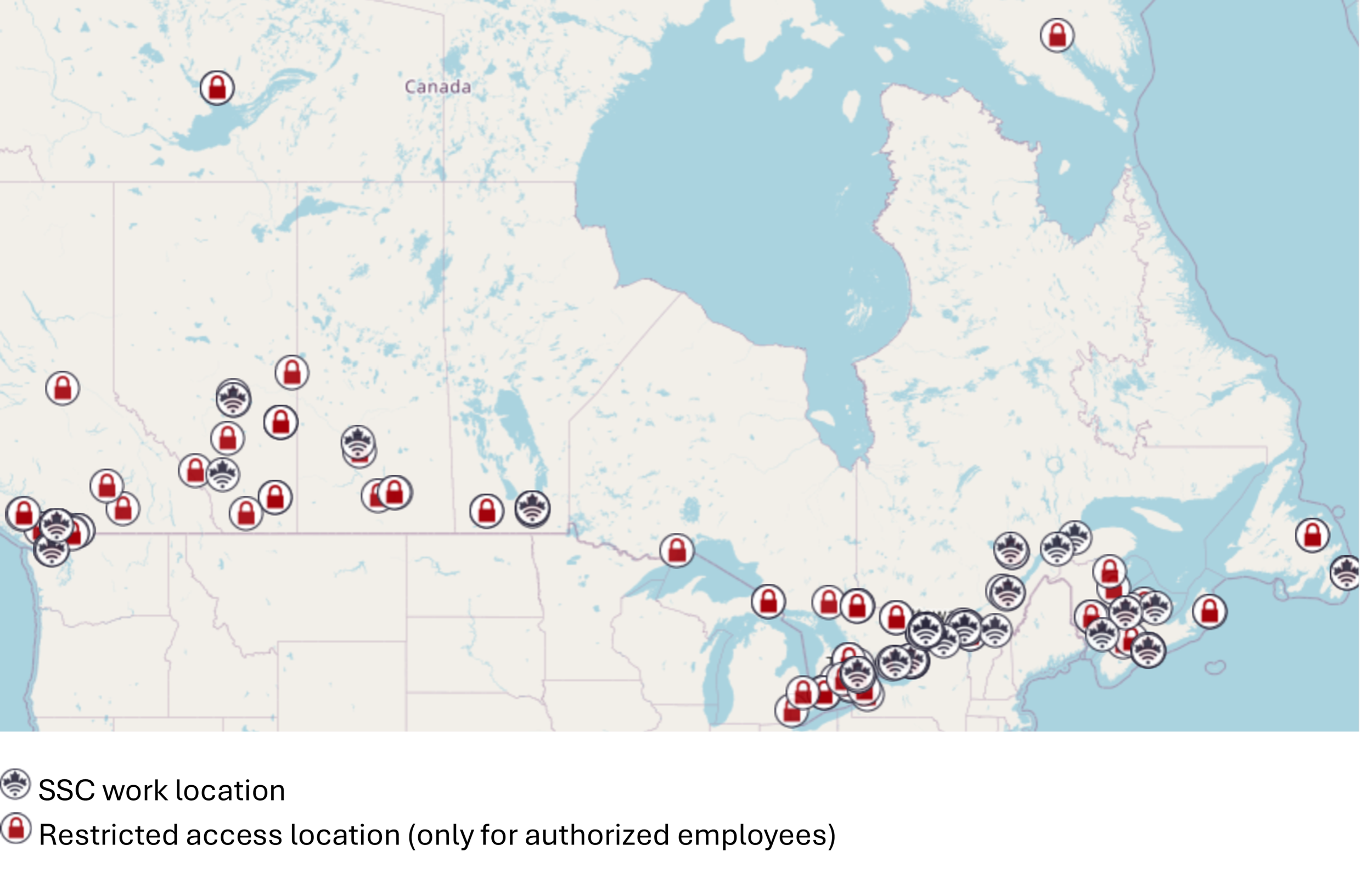
Digital Together and One SSC
In 2023, SSC set out Delivering Digital Solutions Together for Canada (Digital Together), a strategic approach to ensure that departments are equipped with modern, secure, standardized tools. In 2024 SSC’s leadership set out a goal to become One SSC to deliver Digital Together, representing our commitment to work together as one team, speak with one voice and aim for a common goal.
Where SSC is placed in the GC IT ecosystem
The government digital landscape is complex—and SSC plays a critical role as the GC’s common IT service provider.
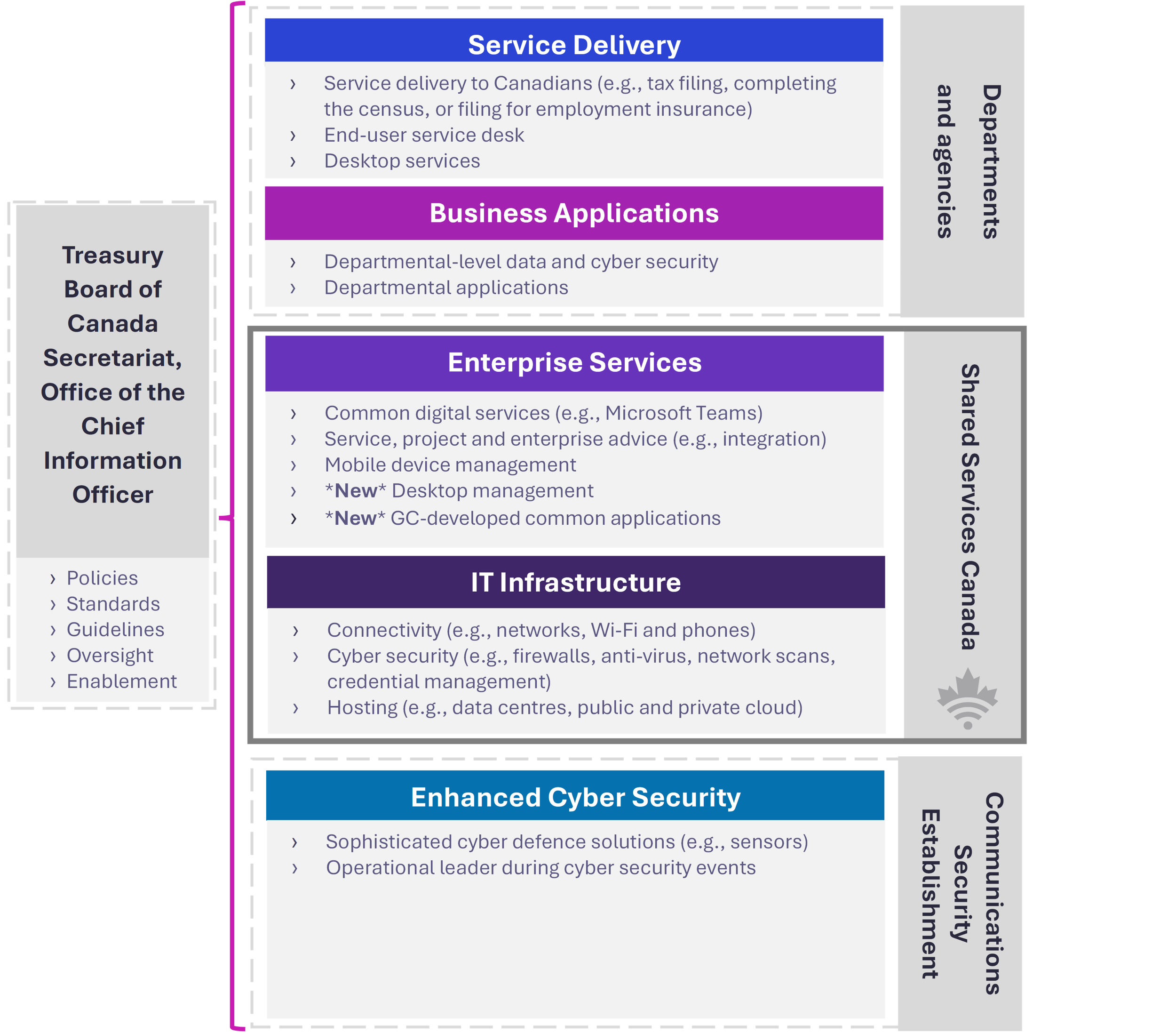
Government of Canada (GC) IT ecosystem - Text version
A graphic depicting the government’s shared role in the IT ecosystem:
- Treasury Board of Canada Secretariat an Office of the Chief Information Officer are responsible for policies, standards, guidelines, oversight and enablement
- Policies
- Standards
- Guidelines
- Oversight
- Enablement
- Departments and agencies are responsible for service delivery and business applications
- Service Delivery
- Service delivery to Canadians (e.g., tax filing, completing the census, or filing for employment insurance)
- Enduser service desk
- Desktop services
- Business Applications
- Departmentallevel data and cyber security
- Departmental applications
- Service Delivery
- Shared Services Canada is responsible for enterprise services and IT infrastructure, like connectivity, cyber security and access, and hosting
- Enterprise Services
- Common digital services (e.g., Microsoft Teams)
- Service, project and enterprise advice (e.g., integration)
- Mobile device management
- New Desktop management
- New GC-developed common applications
- IT Infrastructure
- Connectivity (e.g., networks, WiFi and phones)
- Cyber security (e.g., firewalls, antivirus, network scans, credential management)
- Hosting (e.g., data centres, public and private cloud)
- Enterprise Services
-
Communications Security Establishment is responsible for enhanced cyber security
- Enhanced Cyber Security
- Sophisticated cyber defence solutions (e.g., sensors)
- Operational leader during cyber security events
- Enhanced Cyber Security
Partners and clients
SSC is responsible for providing shared IT services related to email, networks, data centres and employee IT services such as computers and printers. Who must, can and could potentially leverage SSC’s services is a complex question.
- 45 partner departments and agencies must use SSC for email, networks, data centres and employee IT services
- 43 mandatory clients, mostly smaller departments, must use some of the services listed above
- About 60 optional clients (including Crown corporations and Agents of Parliament) may use any of SSC’s services
- Additionally, SSC must provide employee IT services (e.g., computers and printers) to its partners and clients (both mandatory and optional)
- SSC is also permitted to provide services to any person, organization or government (including foreign governments) with the approval of the Governor-in-Council. SSC has provided services to provincial, territorial and municipal governments, primarily contracting for cloud services
Some organizations, such as the Communications Security Establishment (CSE) and the Canadian Security Intelligence Service (CSIS), have distinct requirements and are not required to use the certain services provided by SSC.
Each department and agency remains responsible for their own applications and data.
Order in Council 2015-1071 outlines 4 broad categories of services that SSC must, or may, provide to its clientele.
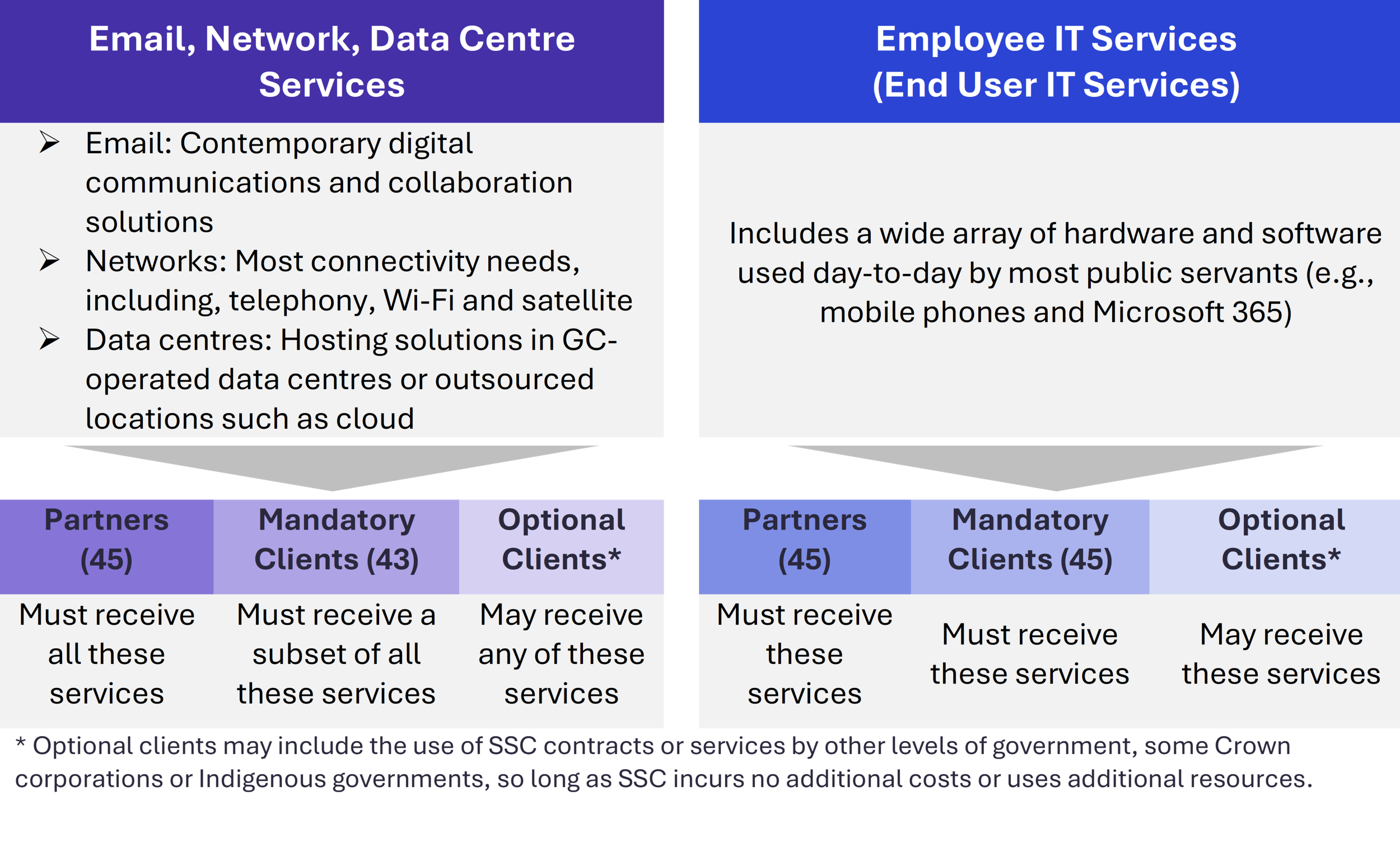
Partner and clients - Text version
A graphic depicting SSC’s partners and clients:
- Email, Network, Data Centre Services have 45 partners, 43 mandatory clients and some optional clients
- Email: Contemporary digital communications and collaboration solutions
- Networks: Most connectivity needs, including telephony, Wi-Fi and satellite
- Data Centres: Hosting solutions in GC-operated data centres or outsourced locations such as cloud
Partner and clients:
- Partners (45): Must receive all these services
- Mandatory Clients (43): Must receive a subset of all these services
- Optional ClientsNote 1: May receive any of these services
- Employee IT Services (End User IT Services) has 45 partners, 45 mandatory clients and some optional clients
- Includes a wide array of hardware and software used day-to-day by most public servants (e.g., mobile phones and Microsoft 365)
Partner and clients:
- Partners (45): Must receive these services
- Mandatory Clients (45): Must receive these services
- Optional ClientsNote 1: May receive these services
Issue notes
Digital services
Issue
Shared Services Canada (SSC) strives to deliver a secure and consistent experience to all Government of Canada (GC) employees through a standardized core suite of digital tools that is accessible, enables seamless collaboration and stays with the employee even if they transfer to another department. GC employees use these tools to deliver on their mandates and provide services to Canadians.
The suite of digital tools is accessible anytime, anywhere, from any government-issued device, enhancing productivity and collaboration among employees and when interacting with Canadians and businesses.
Background
Historically, services provided to GC employees were managed and delivered independently by departments and agencies. This decentralized approach led to duplication of effort and inconsistent employee experiences. Consequently, operational costs were higher, scalability limited and employee productivity was impacted. By adopting a centralized strategy to equip employees with modern tools, SSC aims to reduce costs, improve efficiency and enhance security.
SSC’s vision for digital services promotes a standardized, enterprise-wide approach to delivering secure and accessible digital tools. The Enterprise Service Model (ESM) provides services through 2 tiers:
- First-tier: This includes failproof services that employees can use no matter where they are, such as cellular services, a digital communication and collaboration suite enabled through Microsoft 365, and GC emloyee tools (e.g., peripherals).
- Second tier: This includes enterprise business services that are tied to government buildings, such as landline phones and cell coverage inside buildings. These services have alternatives, such as using a mobile phone instead of a landline.
A key demonstration of the value of SSC’s ESM is the Mobile Device Service (MDS). Through MDS, SSC manages over 219,000 smartphones across more than 50 organizations, ensuring secure, always-available access to communication and collaboration tools. This centrally managed service offers:
- Cost efficiency: Bulk procurement and centralized management reduces costs
- Increased security: Common controls ensure compliance
- A seamless and standardized experience: Employees retain their devices and phone numbers when transferring between departments and agencies, ensuring seamless transitions and a consistent experience while reducing electronic waste
The success of MDS prompted SSC to extend the Enterprise Service Model to other critical services, including email, conferencing and softphones. This lowers costs, for example, by using our market power to lock in competitive rates for M365, or by using softphones, which have lower costs than traditional telephony. There are opportunities to expand this model to desktop services, which securely connects GC employee tools and employees through GC directory services.

Considerations
Digital communications and collaboration
SSC is transforming email and office applications, like word processors and spreadsheet software, by transitioning to a consolidated cloud-based solution. The M365 platform is used to provide employees with modern collaboration tools that function efficiently in a hybrid environment and improve communications with stakeholders across the country. M365 includes a comprehensive suite of workplace applications, including Teams (text and video chat), Outlook (email), SharePoint (group file share) and OneDrive (personal file share).
| Email migrations to M365 | Completed | Planned | |
|---|---|---|---|
| 38 partners | 7 partners remain |
Contact centre services
SSC procures and manages technical solutions that enable partners to leverage contact centre capabilities such as voice, chat, email or videoconference, call-back and self-serve options, as well as support for artificial intelligence (AI) chatbots.
SSC-supported contact centres include Employment Insurance, the Canada Pension Plan and the Canada Revenue Agency, as well as smaller centres such as Non-Insured Health Benefits for Indigenous Services Canada and Marine Safety and Security for Transport Canada.
| Contact centre | Current contact centres supported | Migrating to new solutions | |
|---|---|---|---|
| 248 | 63 |
Mobile device service
SSC ensures that employees can securely access GC networks and data using mobile devices and tablets, providing them with modern work capabilities anytime, anywhere. The initiative manages approximately 219,000 handheld devices (iOS and Android) across 45 partners and 6 client departments. SSC is focused on ensuring a high level of service availability, deploying new features, and expanding the service to include security and support requirements for classified services.

| Partners and clients managed by MDS | Managed | Planned | |
|---|---|---|---|
| All 45 partners 6 clients |
9 additional clients |
Softphones
SSC is adopting an enterprise approach to improve the delivery of telephony services and enable a mobile workforce. It is replacing outdated systems with modern solutions, such as a softphone service that allows employees to place and receive phone calls from their computer or phone using any Internet connection. This will provide unified communication services that can be accessed securely from any GC-issued device anywhere, anytime, at reduced cost.

| Softphones | Deployed | Planned | |
|---|---|---|---|
| 97,000 | Entire enterprise |
Fixed phone line rationalization
As SSC modernizes its services, it is important that we transition away from older solutions. Traditional wired office desk phones are no longer useful for many employees and are costly to maintain. SSC has been working with partners to retire all non-essential lines, with a target to retain only 10% of fixed lines within the next 3 years.
| Fixed lines disconnected | Disconnected | Disconnections in process | Remaining to validate | |
|---|---|---|---|---|
| 161,000 | 14,300 | 94,000 |
Next steps
Digital services will provide access to an extended standardized core bundle of tools to include desktops and laptops, enabling work anywhere, at any time, from any GC-approved device. This approach will ensure cost-effective, secure and accessible services and tools that improve communication, mobility and productivity for employees. These tools are needed to transform the public service and improve services for Canadians.
To ensure maximum value and interoperability are achieved across the standardized bundle of tools, a set of common administrative tools is required. This will provide oversight and management of enterprise services, proactively detect issues and aid in the accelerated deployment of future capabilities. Through additional data insights, SSC will ensure that costs and outcomes are tracked consistently, including reporting on the consumption of enterprise services to inform data-based decision making.
SSC is actively working to strategically deploy generative AI-driven tools to elevate employee productivity across government. By introducing AI assistants, employees will be empowered with tools that automate routine tasks and provide real-time information, helping to amplify their productivity. Moreover, the adoption of AI chatbots is poised to streamline contact centre operations, allowing employees to focus on more complex inquiries and value-added activities.
SSC will continue to modernize its services, further enabling a mobile workforce with standardized digital tools for increased collaboration and productivity, improving the GC’s service delivery to citizens.
Artificial intelligence
Issue
Artificial intelligence (AI) is considered to be a transformational technology, which stands to propel significant social and economic progress. Following the release of generative AI tools like ChatGPT, media and public interest in AI has grown.
The Government of Canada (GC) recognizes the transformative impact of AI on its operations and service delivery to Canadians. AI can revolutionize how public servants work by automating routine and repetitive tasks, allowing employees to concentrate on tasks that require more human insight, innovation and analytical reasoning. This shift could result in heightened efficiency, increased job fulfillment and improved retention of skilled personnel. Leveraging AI’s capabilities, the government aims to streamline its processes, enhance its agility in responding to the needs of citizens and utilize its resources more effectively.
Background
Governments and organizations around the world are exploring AI’s potential to improve services and reduce costs. Shared Services Canada (SSC) was one of the first departments in the GC to establish an AI program. Since 2019, the SSC AI Centre of Excellence (AICoE) has led the charge in advancing AI adoption, incubating over 30 AI use cases, both within SSC and in partnership with various departments. SSC is leveraging AI to enhance the work experience for its employees and other public servants, making it more efficient and cost effective, while also safeguarding Canadians’ privacy and security.

What is AI?
AI is a broad concept encompassing various processes and technologies.
Common terms associated with AI include generative AI, machine learning, natural language processing, computer vision and deep learning. Additionally, applications such as robotic process automation (RPA) and intelligent automation (IA) fall under the AI umbrella.
- AI involves machines performing tasks that typically require human intelligence, such as problem-solving, reasoning and language processing.
- RPA is an application that automates routine tasks to streamline workflows and enhance efficiency.
- IA combines AI and RPA to enable machines to perform tasks requiring human-like judgment and learning, while streamlining complex processes and improving efficiency and accuracy.
Canada’s AI approach
The GC is advancing AI development domestically and within its operations.
The development and training of AI models requires substantial computing resources. Budget 2024 allocated funding to support Canadian researchers, start-ups and scale-up businesses in developing AI infrastructure in Canada. The Budget also funded the creation of the AI Safety Institute, employee skill development and a smaller secure computing facility led by SSC and the National Research Council Canada for government and industry research and development, including national security purposes.
To assist departments with responsibly deploying automated decision-making systems, the Treasury Board of Canada Secretariat (TBS) released the Directive on Automated Decision-Making, the Guide on the use of generative artificial intelligence and the Algorithmic Impact Assessment tool.
Furthermore, with the participation of SSC and other departments, TBS led the development of Canada’s first AI Strategy for the Federal Public Service, which will ensure that AI is deployed in a responsible, inclusive and human-centric manner. The GC AI Strategy was published in March 2025.
Considerations
Global concerns surrounding AI development have emerged, particularly in the area of governance and risk management. Key issues include:
- legal, ethical and operational issues, including privacy and security
- substantial costs and potential environmental impacts for computing resources and electricity
- limited regulatory oversight and governance
- fears of “lagging behind” that may lead to the hasty adoption of new technologies
- varied benefits across sectors of an organization
- the rapid expansion in AI-integrated technologies
- the necessity for a common approach to AI development, investment and management
- the need for a standardized AI governance framework to support responsible AI development
- the need to recognize AI’s role and limitations
- use of AI by cyber threat actors in sophisticated attacks against critical infrastructure and public services
SSC has shown its dedication to the responsible and ethical development of AI solutions by integrating the Algorithmic Impact Assessment tool into its project management process, releasing an SSC guide on the use of generative AI and creating a use case assessment model to assess AI applications for value and feasibility.
Next steps
SSC has been exploring how to make the best use of AI to transform the way government operates and provides services to Canadians. These business cases can create value, reduce costs and enhance efficiency. Across the government, SSC is:
- working toward expanding its role: SSC is working with other departments and agencies to identify and drive AI opportunities that benefit the entire government.
- updating the departmental AI Strategy and vision: Ensuring that SSC is well-equipped to support the GC’s AI needs, particularly in areas such as data management, analytics and automation.
- exploring the delivery of innovative solutions: This includes delivering AI-enhanced chatbots, automated workflows and predictive analytics to departments and agencies. These efforts aim to elevate service quality and reduce expenditures.
- working towards the creation of an AI marketplace: This marketplace will share GC-developed code and solutions from successful initiatives across departments and agencies. This will minimize redundant efforts and enhance return on investment. It will also facilitate collaboration to bolster AI innovation and research.
- leading and chairing GC-wide AI and intelligent automation working groups, professional communities and governance forums: Focusing on AI innovation, AI literacy, knowledge-sharing, governance and collaboration.
- GC AI Hub: A community-driven, trusted first stop for AI automation. The SSC-led GC AI Hub is a living ecosystem that thrives on knowledge and experiences shared by the GC AI community, and it promotes AI and automation use cases throughout the public service.
- continuing its collaboration with TBS to create and refine key policy documents, guidelines and best practices.
- providing expert peer-review support to departments: Ensuring adherence to the TBS Directive on Automated Decision-Making and reinforcing the integrity of decision-making systems.
Annex: AI use cases
AI use cases at SSC
- CANChat – This is a conversational chatbot tool developed by SSC to enhance employee productivity and unlock creative potential using AI. Recognizing the importance of data security and privacy in government operations, CANChat provides an in-house alternative to commercial generative AI tools such as ChatGPT. CANChat can assist in creating emails and memos, edit documents, quickly summarize information, provide summaries on complex topics, as well as generate meeting agendas and talking points. All of this is done within a controlled environment that ensures appropriate security and data integrity. SSC is also developing the architecture and service controls to offer CANChat as an enterprise service to all departments.
- SSC Assistant – This chatbot helps SSC employees find the information they need through a simple interactive conversation. Employees can research any unclassified topic related to their work or retrieve the contact information of other employees. It sources information from corporate tools, SSC’s intranet and the Internet.
- Security Management and Government Turbo SA/A – This tool will optimize the existing Security Assessment and Authorization (SA/A) review process, which ensures only authorized software and hardware is implemented at SSC. It will use AI to validate evidence against required security controls and identify anomalies.
- RPA of Access to Information and Privacy (ATIP) requests – This tool, originally developed by SSC, automatically eliminates duplicate records and indexes information to save time and ensure analysts stay focused on higher-value work. This allows ATIP requesters to receive their responses faster. The code was shared with 7 departments, and Transport Canada is now working on improving the tool.

Examples of AICoE assistance across government
- Public Services and Procurement Canada (PSPC) – MyPay Enquiry Process – In collaboration with SSC, PSPC automated portions of its MyPay Enquiry Process to optimize how it works. This will help reduce the backlog and increase the productivity of a compensation advisor by at least 30%.
- Department of Finance (FIN) – US tariffs public consultation – SSC helped the Department of Finance use generative AI and RPA technology to develop a tool that automates the collection and processing of tariff consultations, summarizes industry data and drafts initial responses for analysts and stakeholders.
- Canadian Heritage (PCH) – Ministerial correspondence – In collaboration with SSC, Canadian Heritage used automation and generative AI to refine the ministerial correspondence process, achieving a reduction in routing errors and enhancing both the speed and quality of responses.
- Employment and Social Development Canada (ESDC) – Partnering with SSC, ESDC leveraged shared CANChat code to streamline the development of its own AI chatbot, EVA, significantly cutting down on development time and accelerating its implementation.
GC AI use cases
Within the GC, the majority of departments are actively exploring AI and automation to modernize their services and boost employee productivity. However, this approach risks creating duplication and deviation from work that does not consistently align with shared standards and best practices. As work progresses on the AI strategy for the federal public service, SSC is positioning itself as a thought leader and technology expert, sharing and contributing to the development of best practices, standards and guidelines to ensure efficient and harmonized AI adoption across the government.
Examples of AI use cases in the GC include:
- Canada Revenue Agency (CRA) – Instead of waiting for a security code by mail, CRA now allows Canadians to gain access to their secure accounts right away using facial recognition technology, a smartphone and government-issued ID. More than 1 million taxpayers have already used the service.
- Employment and Social Development Canada (ESDC) – Machine learning is helping improve service delivery of the Employment Insurance (EI) program. Automation is reducing the manual intervention required every time an EI client provides new information or has a change in their circumstances. This is improving the accuracy of EI benefit calculations.
- Immigration, Refugees and Citizenship Canada (IRCC) – Advanced analytics and automation help streamline application processing for a better client experience.
- Transport Canada (TC) – Advanced analytics help identify and mitigate high-risk air cargo shipments before they are transported to Canada, enhancing security measures.
- Communications Security Establishment (CSE) – AI assists in cyber defence by helping enable the detection of a variety of threats, including identifying previously unseen malware on government networks and quarantining it.
Hosting services
Issue
Shared Services Canada (SSC) provides a modern, secure, reliable and secure ecosystem that enables the GC to deliver digital services to Canadians. Hosting services provide the necessary facilities, information technology (IT) infrastructure, software, security and support to run the Government of Canada’s (GC) applications and data.
SSC is modernizing its hosting model, which combines cloud services and traditional data centres to optimize performance, reduce costs and provide flexible solutions to respond to partners’ evolving needs.
Background
At its inception in 2011, SSC inherited sprawled, siloed IT infrastructure: thousands of applications, tens of thousands of servers, hundreds of data centres and hundreds of cloud environments.
Over the years, SSC has modernized the GC’s hosting approach. Initially, SSC was only consolidating legacy systems into modern data centres. Then, the GC introduced a Cloud Adoption Strategy to encourage the use of cloud services alongside traditional data centres. This evolved into a “cloud-first” policy in 2018, prioritizing cloud for new applications. In the intervening years, the GC recognized the need to address the rising costs associated with this shift and implement greater rigour in the types of information hosted in the cloud, through a whole-of-government approach.
The 2024 GC Application Hosting Strategy promotes an approach that balances cloud flexibility with the reliability of GC enterprise data centres (EDC). This balanced approach gives departments the flexibility to choose the right environment for their applications and data—whether for scalability, performance or security—while protecting sovereignty when required. Under this hybrid approach, SSC will help partners determine the best hosting option for each application to ensure the greatest value for Canadians. Furthermore, standardization supports cost-efficiency, rapid deployment, resilience and interoperability.

SSC is advancing the hybrid model through several key areas:
- Cloud services – Providing secure, scalable and flexible cloud solutions, including public, private and hybrid cloud, to enable departments to rapidly deploy and manage digital services while optimizing costs.
- EDC services – Delivering reliable GC-owned and operated hosting in Canada that consolidates and modernizes IT infrastructure, ensuring high availability, efficiency and security.
- Core platform, application, data and software services – Providing the essential IT environments for applications and data. This includes managing operating systems, databases, platforms and storage to ensure secure, reliable and efficient digital services for departments.
- Enterprise applications – Supporting GC-wide digital transformation by providing and managing shared applications that streamline operations and enhance service delivery to Canadians.
Example: Enterprise data centres
SSC manages multi-tenant modern, reliable and secure EDCs in Barrie, Borden, Montréal and the National Capital Region. They maintain the highest redundancy levels to minimize the risk of downtime for the critical applications delivering important services to Canadians. Access is highly restricted and security standards offer the highest level of protection. EDCs meet at least the LEED Silver standard.
Example: Federal budget, Statistics Canada
In collaboration with Finance Canada, SSC improved the federal budget website by moving it to the cloud. Nationwide, content availability improved to 20 seconds from 20 minutes, allowing millions of budget day requests. This solution automatically scaled down after peak demand. The solution costs approximately $100 a month, requires no server maintenance and can handle high traffic without issue.
SCC is also supporting Census 2025 by partnering with Statistics Canada and using scalable, pay-per-use, on-demand cloud hosting, avoiding the need for long-term hosting infrastructure.
Considerations
Legacy IT and the Application Hosting Strategy funding gap
The continued use of outdated or obsolete legacy systems represents a significant risk to GC operations. These systems are more likely to fail and create unplanned outages, more costly to maintain, and more vulnerable to security breaches—at a time when bad actors in cyberspace are increasingly aggressive and sophisticated. SSC is working with partners to move many critical applications off unstable aging physical infrastructure and has decommissioned over 500 of 720 legacy data centres.
The 2023 Report of the Auditor General of Canada noted that nearly two-thirds of GC applications were in poor health and in critical need of modernization. SSC supports the physical infrastructure, including servers, but departments are responsible for their applications. Many of the legacy systems cannot be decommissioned until partners modernize their legacy applications that reside on them. Success depends on strong collaboration between SSC and its partners, and GC alignment on prioritization.
The GC Application Hosting Strategy, approved in July 2024, focuses on replacing siloed hosting solutions with enterprise solutions managed by SSC, allowing partners to focus on their core business. Under the Strategy, a central funding model was to be developed. Without it, the full potential benefits may remain unrealized.
Dependency on partners
A key challenge complicating modernization efforts is the split responsibility between SSC and partner organizations. Individual departments and agencies are responsible for their own applications, while SSC manages the hosting infrastructure for these applications and incurs the costs for maintaining it. This division has led to competing priorities and a lack of financial incentives for partners to modernize their applications. In 2023, the Audit General criticized the slow progress, with the percentage of healthy applications increasing from 33% to 38% from 2019-2023.
Success depends on a united, whole-of-government effort, where departments see themselves as integral parts of a larger initiative.
Rising costs
The costs associated with IT infrastructure and software licences continue to increase. Given the large scale of SSC’s operations, even small cost increases can significantly impact the overall budget. Furthermore, although per unit storage costs continue to decrease, storage consumption is accelerating. Managing these rising expenses is crucial to maintaining financial stability and ensuring the sustainability of GC hosting services.
Vendor lock-in
Relying heavily on a single provider can lead to vendor lock-in, limiting flexibility and increasing dependency on the provider’s ecosystem and pricing, which makes it challenging to negotiate better terms or switch solutions. Migrating to other platforms is also technically demanding and resource-intensive, further complicating efforts to maintain flexibility and control costs. However, managing multiple providers and their associated components may not be more cost-effective than having a single provider. SSC balances these pressures on a case-by-case basis.
Artificial intelligence
SSC is exploring several artificial intelligence (AI) capabilities for the delivery of hosting services. AI and automated threat mitigation software are already being used to prevent cyber attacks and escalations, resulting in significant cost savings and increased security. SSC is also leveraging AI to manage elements of hosting services, scaling resources up or down as demands rise and fall, and providing support to partners, thereby creating efficiencies and reducing costs.
AI can be harnessed to enhance efficiency, security and scalability. By embedding AI, SSC can transform its hosting infrastructure to be more adaptive, resilient and cost-effective, setting a new standard for public sector IT services.
High Performance Computing
High Performance Computing (HPC) powers the advanced analytics, modelling and AI needed to solve complex policy and operational challenges, such as climate modelling. This purpose-built computing is essential for AI training and large simulations. SSC is expanding HPC capacity as a shared service to reduce duplication and enable access across departments, aligning these investments with the needs of science-based departments.
Digital sovereignty
Digital sovereignty is a country’s control over its technology, infrastructure and data to protect its interests. It requires that data be governed by local laws, ensuring compliance and safeguarding sensitive information. SSC’s EDCs in Canada help protect Canadian data. The penetration of US technology vendors in the cloud computing space is significant. In response, SSC is currently working with select Canadian cloud service providers to assess if these vendors can meet GC sovereign hosting requirements.
Next steps
SSC will continue to evolve its hosting procurement strategy and its hosting services to ensure the GC can meet the needs of Canadians. For example, AI offers massive potential, but to unlock that potential, the GC needs an underlying IT infrastructure that is secure, scalable and aligned with the responsible use of data.
Modern hosting is the engine driving secure, efficient and innovative service delivery. SSC’s hosting approach will strengthen data sovereignty, enable scalability and speed, improve cost effectiveness and boost reliability—all to meet the evolving needs of the GC and its citizens.
Cyber security services
Issue
Cyber security is a key aspect of the services provided by Shared Services Canada (SSC).
Cyber threats are becoming more complex and sophisticated, posing risks to our national security and economic prosperity. These threats include criminal activities such as ransomware attacks and state-sponsored adversaries. Cyber security incidents also affect public services and trust in institutions. Rebuilding systems after successful attacks can be costly.
The Government of Canada (GC) continuously works to enhance cyber security in Canada by preventing attacks through robust security measures, identifying cyber threats and vulnerabilities, and preparing for and responding to cyber incidents.
Annually, SSC’s cyber security services block:
- nearly 6.5 trillion attacks attempting to disrupt the availability of online services
- 7,000 phishing and malware email campaigns
- 135 billion events
Background
SSC manages IT infrastructure using multiple layers of defences for protection. It runs secure networks, with restricted access, that connect to modern hosting services, which are controlled, updated and monitored at an enterprise level. SSC collaborates with other departments and agencies to integrate cyber security best practices into their operations involving applications and data.
SSC ensures the security of GC systems with advanced enterprise infrastructure and security services. These include firewalls, network scans, anti-virus and anti-malware, as well as identification and authentication tools. The department addresses known vulnerabilities by updating software, drivers and firmware.
SSC is adopting a zero trust approach to security, which is based on the principal that no person or device should be trusted by default, even if they are already within an organization’s network. This approach restricts users’ access to information using a GC-managed device based on their security credentials, ensuring they only have access to what they need to see.
Legacy systems are more costly and difficult to protect. By standardizing and consolidating IT across the GC, SSC is reducing the number of potential threats that could exploit system vulnerabilities.
A shared responsibility
Cyber security in the GC is a shared responsibility. SSC, the Treasury Board of Canada Secretariat’s (TBS) Office of the Chief Information Officer (OCIO), and the Canadian Centre for Cyber Security (CCCS) within the Communications Security Establishment (CSE) each play key roles.
TBS leads on a whole-of-government cyber security policy and provides strategic oversight for managing cyber security events.
CSE serves as Canada’s technical and operational authority for cyber security. Together with the CCCS, CSE provides cutting-edge services to prevent cyber incidents. These services include deploying sensors to detect malicious cyber activity at the host, cloud and network levels, and coordinating the reporting of cyber attacks. Their automated defences protect the GC from over 6 billion malicious actions daily.

Other stakeholders
Public Safety Canada (PS) leads the National Cyber Security Strategy, a whole-of-society strategy, working with stakeholders outside of the GC to protect Canadians and businesses from cyber threats.
The Royal Canadian Mounted Police (RCMP) is the primary investigative authority on all cyber security incidents dealing with actual or suspected cybercrime of non-state origin against GC infrastructure.
The Canadian Security Intelligence Service (CSIS) collects information and intelligence on activities suspected of constituting threats to the national security of Canada, and supports departments and agencies through security screening and foreign intelligence collection.
The Canadian Armed Forces (CAF) collects and shares cyber threat intelligence with allies. In collaboration with CSE, the CAF conducts foreign cyber operations. It recently consolidated its capacities in the new Canadian Armed Forces Cyber Command (CAFCYBERCOM).
Partner departments are responsible for identifying security requirements and implementing security controls to meet the needs of their programs and services. They actively monitor their systems and applications, and work with CCCS, TBS and SSC to address cyber events when they occur.
Cyber event management and planning
The GC Enterprise Cyber Security Strategy aims to shift the GC toward a proactive cyber security approach by enhancing training, applications, policy and monitoring. The Strategy encompasses yearly risk management, talent development, third-party risk management and the establishment of a new team to emulate techniques used by malicious threat actors.
Robust processes are essential for responding to cyber attacks. The Government of Canada Cyber Security Event Management Plan (GC CSEMP) provides a framework for managing cyber security events that impact the GC’s ability to deliver services to Canadians. GC CSEMP outlines responsibilities across government for various levels of cyber events: low-impact events are managed by the responsible department, while more serious events are led by teams coordinated by TBS and the CCCS.
During a cyber event, SSC’s internal GC-facing responsibilities include monitoring for unusual network activity, blocking cyber threats and assessing service impacts. It also includes reporting and implementing prevention, mitigation and recovery efforts such as patching and isolating infrastructure.
The GC CSEMP response level determines the governance structure to direct and facilitate mitigation and recovery activities during a cyber event. The lead minister for the response is determined on a case-by-case basis, depending on the context of the event.
Considerations
Supply chain integrity
Advanced cyber threat actors are increasingly attempting to bypass traditional defences by introducing vulnerabilities into organizations’ supply chains. This can occur by modifying equipment during manufacturing (before delivery and/or during maintenance) or by introducing vulnerabilities in software at any point during the life of the product.
Since 2012, SSC has been mitigating this risk through supply chain integrity (SCI) procurement reviews when purchasing equipment, software or services. SCI assessments enable departments and agencies to identify and potentially mitigate security vulnerabilities. These reviews examine suppliers, subcontractors and equipment, including hardware, firmware and software, that will be used to create, store, process or transmit GC information. This CCCS assesses this information against 3 pillars:
- sensitivity (i.e., the context in which the equipment or applications will be used)
- ownership (including foreign control and influence)
- technical (i.e., whether there are known vulnerabilities or concerns about hardware or software)
The assessment determines if there is a low, medium or high risk that products could be compromised. Bidders have opportunities to address concerns raised by the assessment and the GC can require mitigations. Over 83,000 SCI reviews have been completed to date.
Small departments and agencies
SSC is working with 43 small departments and agencies (SDAs) to offer IT services, including enterprise Internet, email, remote access, local Internet service and software to detect malicious activity. This initiative addresses a significant gap identified by a 2022 National Security and Intelligence Committee of Parliamentarians Special Report, which found that SDAs outside SSC’s enterprise Internet service were more vulnerable to security threats. SSC’s focus on an enterprise approach to network, security and digital services ensures stronger cyber security and cost efficiency across the whole of government. By the end of 2024-25, 23 SDAs had been fully onboarded to Internet and remote access connectivity service solutions, and 15 had migrated to the enterprise email solution.
Next steps
As threat actors continue to use artificial intelligence (AI) to launch more sophisticated cyber attacks, the GC will continue to leverage AI for security purposes. For example, firewalls, anti-malware and other tools now incorporate AI, accelerating our defensive processes.
SSC will continue to enhance the GC’s cyber security resilience by identifying gaps and opportunities, delivering new enterprise capabilities and preparing for, responding to and recovering from cyber attacks. Continuous investments in preventing incidents and strong cyber security defences are key to protecting the GC’s ability to function properly and deliver the services that Canadians rely upon.
Procurement
Issue
As the single largest purchaser of goods and services in Canada, the Government of Canada (GC) recognizes its role in supporting and growing Canadian businesses. Each year it purchases approximately $37 billion in goods and services. Shared Services Canada (SSC) and Public Services and Procurement Canada (PSPC) manage over 75% of the value of these purchases.
In 2023-24, SSC executed 12,320 contract transactions valued at approximately $4.3 billion, including awarding $549 million in contracting activities to Indigenous businesses.

Background
SSC conducts fair, open and transparent procurement.
All GC contracting is subject to controls through laws, regulations and government-wide policies, directives and guidelines. SSC complies with the Financial Administration Act (FAA), the Government Contracts Regulations, the Directive on the Management of Procurement, the Policy on the Planning and Management of Investments, as well as trade agreements, the Policy on Green Procurement, the Procurement Strategy for Indigenous Business and the Nunavut Directive.
As a common service provider, SSC leverages the collective buying power of partners across government to ensure that the GC receives the best possible value for Canadians. This scale and standardization also reduces operational costs.
Working with industry allows SSC to leverage the large-scale investments that these firms have made in other public sector and private markets to obtain cost effective, secure and reliable off-the-shelf products and highly specialized solutions.
For example, weather forecasts, advisories and warnings require high-performance computing capacity. These types of supercomputers are a highly specialized domain that would cost more if developed and delivered by SSC in-house.
Considerations
Non-competitive contracts
While the majority of SSC contracts use a competitive bid process to achieve the best value, SSC may award non-competitive contracts when justified and aligned with government policy. For instance, equipment must sometimes be procured from specific original equipment manufacturers to ensure compatibility with existing infrastructure, supported by technical justification.
All non-competitive procurement strategies are justified through applicable exceptions to competitive bidding under the Government Contracts Regulations and the limited tendering provisions under trade agreements. Permitted exceptions include pressing emergencies (such as an imminent life-threatening situation), low-dollar value, not in the public interest (such as issues of national security) and when only one provider is capable of providing the service or the equipment (such as exclusive intellectual property). Like competitive contracts, non-competitive contracts are reviewed by SSC’s governance bodies based on risk and value.
In the case of no-substitute non-competitive contracts, the procurement must be supported by technical justification. In some cases, the requirement is competed among resellers of the specific equipment required.
Outsourcing
Accessing industry expertise enables SSC to provide solutions and services that are aligned with global best practices. Professional services provide capacity, specialized advice and skills on an as-needed basis that the government does not have.
In 2024, SSC strengthened its controls on the procurement of professional services to enhance integrity and efficiency, reflecting updated practices across government. These changes ensure that internal options are considered before outsourcing work, clarify the scope of work for contractors, require contractors to disclose concurrent projects and impose stricter reporting requirements.
As part of a government-wide effort, SSC reduced the use of external management consultants. SSC’s expenses on professional services decreased from $477 million in 2022-23 to $437 million in 2023-24.
Agile procurement
SSC is actively working with industry to make procurement more efficient, more flexible and less administratively burdensome for businesses.
SSC’s agile procurement is a collaborative and innovative approach. Agile procurement uses challenge-based solicitations, focusing on problem resolution and allowing industry to propose innovative solutions. It uses teams of technical and contracting experts. It also engages industry, resulting in more flexible and scalable solicitations and contracts. SSC has been incorporating agile procurement principles into its broader contracting. By being more collaborative with vendors, SSC increases the breadth of innovation and creativity involved in delivering services to Canadians.
Example: ScaleUp
In 2021, SSC established ScaleUp, a social procurement initiative that aims to simplify the bidding process, incorporate agile concepts and increase the diversity of bidders on contracts up to $229,600 (a threshold aligned with the Canada-European Union Comprehensive Economic and Trade Agreement). ScaleUp targets Canadian micro and small businesses led or owned by women, visible minorities, people living with a disability and Indigenous Canadians by setting aside procurements for those groups during competitive solicitations. To date, SSC has awarded more than 23 contracts, ranging from $10,000 to $238,000, to 21 different suppliers through the ScaleUp initiative. Among these suppliers:
- over 60% are first-time winning bidders with the GC
- over 30% are micro businesses (4 employees or fewer), whereas 68% are small businesses
- over 50% are owned or led by visible minorities
- over 40% are owned or led by women
- 8% are owned or led by persons with a disability
- over 15% are Indigenous
Speed
As cyber innovation continues to accelerate, the duration of existing procurement processes can impact access to the most advanced IT solutions. SSC is exploring agile procurement approaches to access the latest solutions.
Indigenous procurement
SSC is committed to increasing the participation of Indigenous businesses in procurement as part of the GC’s broader reconciliation goals. In 2023-24, 10.3% of the value of SSC-funded contracts and amendments were awarded to Indigenous businesses, as confirmed by their inclusion in the Indigenous Business Directory managed by Indigenous Services Canada.
SSC has implemented standing offers and supply arrangements with Indigenous considerations and continues to seek opportunities to include Indigenous considerations in new and renewed methods of supply. SSC creates opportunities for Indigenous businesses to participate in contracting by piloting the inclusion of Indigenous Participation Plans in sectors with limited Indigenous business capacity. These plans seek benefits such as Indigenous subcontracting, employment and skills training.
For all procurement greater than $5 million, SSC reviews the requirement to determine if additional Indigenous considerations could be included.
IT market dynamics
Ongoing global and market IT trends continue to affect the government’s procurement approach. Inflationary pressures and rising IT infrastructure costs present a risk to the sustainability of critical digital transformation initiatives. Volatility in public cloud pricing and an increased reliance on cloud technologies could impact budgets and reduce flexibility in scaling operations efficiently.
The Canadian Centre for Cyber Security’s (CCCS) National Cyber Threat Assessment 2025-26 highlighted the trend of increased vulnerability due to vendor concentration. When a high percentage of Canada’s IT systems are protected by a single vendor’s platform, any vulnerability affecting it could result in a more widespread compromise.
Furthermore, rising international tensions could lead to trade restrictions, regulatory changes or shifts in foreign investment policies that affect access to critical IT suppliers, technologies or infrastructure. This could increase costs, delay projects and create dependencies on a narrower set of vendors, reducing competition and innovation.
SSC will continue to proactively monitor these risks and build resilient procurement strategies, such as diversifying suppliers, investing in sovereign domestic capabilities and ensuring compliance with evolving national security requirements.
Next steps
SSC has been working alongside the CCCS and TBS to lead activities to implement an IT Diversification Strategy. This aims to reduce current vendor concentration in strategic areas by diversifying SSC’s approach across its technology footprint, procurement vehicles, future projects and operational activities. It balances strategic considerations related to technical complexity, supportability, integration, risk and cost, while promoting made-in-Canada solutions to bolster the nation’s prosperity.
Artificial Intelligence (AI) capabilities are increasingly being integrated into the hardware and software SSC procures. These tools can help increase efficiency and complement the purpose-built AI tools being developed and purchased for the GC.
SSC is collaborating with TBS to establish the necessary AI governance framework to ensure responsible deployment and management of AI technologies, with a focus on supply chain integrity and sovereignty. This framework will align with TBS best practices, guardrails and guidelines aiming to establish ethical standards, regulatory compliance and best practices. It also prioritizes secure and sovereign procurement processes that strengthen the resilience of the government’s digital infrastructure.
Annex: SSC procurement authorities
The Shared Services Canada Act and Order-in-Council 2015-1071 give SSC the unique ability to procure necessary goods and services to meet its GC partners’ and clients’ digital needs. The Directive on the Management of Procurement outlines SSC’s contracting limits.
The minister responsible for SSC is legislatively empowered to exercise some of the same procurement powers as PSPC to deliver mandated services. SSC uses its authorities to procure goods and services on behalf of other departments and agencies in the GC.
Basic contracting limits
- Goods:
- Competitive contract limit: $75 million
- Non-competitive contract limit: $3.75 million
- Services:
- Competitive contract limit: $37.5 million
- Non-competitive contract limit: $5.75 million
- Specialized services: Non-regulated telecommunications services:
- Competitive contract limit: $300 million
- Non-competitive contract limit: N/A
Emergency contracting limits
The minister responsible for SSC may enter a non-competitive contract up to a total value of $25 million in response to pressing emergencies at departments where there will be significant human and/or financial risks, subject to TBS reporting conditions.
Exceptional contracting limits
SSC may enter into and amend non-competitive contracts for up to $22.5 million to support IT operations for the GC where intellectual property rights of the supplier prevent the contract from being competed.
SSC may enter and amend non-competitive contracts for maintaining existing cloud services for up to $15 million until March 31, 2026.
Justifications for non-competitive contracts include:
- a pressing emergency in which delay would be injurious to the public interest
- where the contract does not exceed s.6(b) Government Contracts Regulations prescribed dollar limits ($25,000 for goods and $40,000 for services)
- circumstances where it may not be in the public interest to solicit bids
- only one person or company is capable of performing the contract
Connectivity services
Issue
Shared Services Canada (SSC) ensures that the Government of Canada (GC) network and connectivity are maintained, allowing public servants to securely connect anywhere, at any time, both across Canada and internationally.
Background
At any given moment, a user’s access to GC networks must be secure. Simultaneously, these networks must be capable of managing rapid and substantial fluctuations in bandwidth demand.
SSC inherited a complex and aging network infrastructure that was tailored to each individual department and agency. This infrastructure was costly to maintain and did not support the modern cloud, video and voice services that public servants require to deliver services to Canadians.
Since then, SSC has consolidated and modernized network information technology (IT) infrastructure through standardized technology and contracts, simplifying administration. Designing the network to be secure from the ground up minimizes flaws that could compromise security. Consolidating and standardizing to a common, shared, enterprise network improves reliability and stability. It also reduces the time and effort spent on maintenance and troubleshooting.

SSC’s approach leverages software-defined network infrastructure to automate traffic flow and maintenance. This is implemented in 4 GC Networks Hubs across Canada. SSC has installed hubs in Toronto, Montréal and Vancouver, and is evolving the distributed hub in the National Capital Region (NCR) by adding capabilities and moving it from its current legacy locations into modern facilities. Additional hubs are likely to be established in the Prairies and the Maritimes. This strategy is crucial for managing connectivity and security from the GC network to external networks, such as the Internet and public cloud.
SSC has shifted to a “whole-building approach” when providing the Wi-Fi that enables employees to seamlessly use modern digital tools. This means installing integrated, modern and secure Wi-Fi for all GC employees in a whole building, rather than just the floors occupied by a requesting partner. This approach not only reduces costs by approximately 66% but is also more environmentally sustainable by decreasing the consumption of copper and precious metals, such as gold and platinum.
Supporting hybrid work
SSC provides connectivity for employees in about 4,000 buildings in Canada and around the world, from the NCR and across the country, to diplomats and Canadian Armed Forces (CAF) personnel stationed abroad. Under the public service’s new hybrid work model, remote employees, businesses and Canadians collaborate with employees in the office. To support the higher demand, SSC significantly increased network capacity and enhanced the functionality of collaboration tools. SSC has made bandwidth upgrades at hundreds of GC sites and added video conferencing capabilities to thousands of boardrooms across the country.
In 2024, an additional 250 sites were identified for bandwidth upgrades, primarily located in regions outside of the NCR. Of these, 34 sites have been upgraded so far, with more upgrades under way as partners identify additional sites in need. As of February 2025, SSC has deployed whole-building Wi‑Fi in over 1,535 buildings and modernized over 1,400 videoconferencing systems in the past year.
Connectivity in remote areas
SSC awards contracts for Low Earth Orbit (LEO) satellite services to provide high-speed Internet connections in remote locations for GC organizations. These services are on an as-and-when-required basis, so the GC only pays for services when they are needed.
LEO satellites operate at a much lower altitude than geostationary satellites and provide encrypted connectivity for vehicles on land and at sea, or for buildings in areas with no traditional coverage from terrestrial or cellular providers. For example, the Department of National Defence (DND) is using the service in Iqaluit and at CAF Station Alert to provide connectivity to their networks.
SSC currently has LEO satellite service contracts with 2 providers and intends to diversify solutions with new providers as they come online.

Providers are selected by SSC based on business requirements set out by departments and agencies. SSC is also exploring other remote connectivity options by working with small and medium‑sized enterprises (SMEs) through the Innovation Solutions Canada program challenge. Through this program, challenges are issued and SMEs submit ideas to address the problems.
Security partners
SSC supports the unique operational requirements of the Royal Canadian Mounted Police (RCMP) and the CAF across Canada and the world.
SSC provides dedicated secure connectivity to DND in approximately 480 Canadian sites, 35 American sites and 19 sites in other countries. Additionally, SSC supports over 50 DND offices co-located in Global Affairs Canada missions around the world.
SSC provides the connectivity that supports RCMP policing operations in urban, rural and remote locations. For instance, the data-intensive body-worn camera initiative aims to improve transparency and accountability. It will equip RCMP officers with a body-worn camera while on duty and store video evidence to support court proceedings and other processes. In support, SSC has been implementing network capacity and control improvements to over 900 sites using combinations of enhanced bandwidth, satellite and local Internet.

SSC is also supporting the RCMP’s work on Next Generation 9-1-1, which will allow the public to use 9-1-1 services using any real-time communication channel—be it voice, text or video—from any wired, wireless or IP-based device. SSC is also delivering and supporting circuits for mission-critical encrypted radio communication system in Ontario and Quebec. These radios will ensure efficient and reliable communication with partner public safety agencies in routine and emergency situations.
Example: Portable backpack connectivity unit
Wildfires frequently destroy communications infrastructure, hampering communications. To provide a critical lifeline to first responders, as well as remote work locations, SSC is exploring a portable backpack unit made by iTel, a Canadian small business. The pack combines Internet connections from cell towers and other sources, like LEO satellites, to provide a single, stable Internet connection. It was used in wildfire response in the Northwest Territories, where it provided temporary Internet access in areas that otherwise had little to no connectivity.

Considerations
Key ongoing considerations for connectivity modernization include factors that are both predictable and unpredictable, such as:
- technology infrastructure and tools continuing to evolve at a rapid pace
- increased frequency and sophistication of cyber security attacks
- continued sudden increases in bandwidth requirements
- ongoing reliance of some partners on legacy and aging infrastructure
Next steps
SSC plans to improve its GC Networks Hubs by integrating the science network connectivity (CANARIE) into the hubs and establishing more domestic and international hubs where appropriate.
SSC is developing new contracting vehicles to provide larger amounts of bandwidth to meet the increasing needs of its partners.
SSC is exploring the use of artificial intelligence to proactively predict network outages and issues before they occur. By forecasting and pre-empting network disruptions, this approach has the potential to significantly reduce downtime and enhance the reliability and performance of the network infrastructure.
Operations
Issue
Shared Services Canada (SSC) collaborates directly with its partner departments and agencies to manage their information technology (IT) services and to ensure the delivery of client-centric and metrics-based services. These operations are crucial to the delivery of services to Canadians.

Background
SSC’s 24/7 operations are varied and complex. They range from monitoring to prevent incidents, upgrading infrastructure, resolving IT incidents and responding to partners’ specific needs.
As the Government of Canada’s (GC) enterprise technology service provider, SSC handles requests for IT services from partners ranging from satellite connections, cabling and secret environments, to providing and servicing a new employee’s computer. SSC oversees the client business processes intake from implementation to billing.
In turn, SSC performs the updates and upgrades needed to ensure that IT systems and infrastructure remain operational to deliver services to Canadians. These changes need to be done when they do not cause disruptions. For instance, no updates are done on Elections Canada systems during the writ.
SSC also resolves incidents and events, such as equipment failures, floods, cyber attacks and vendor outages that could impact services to Canadians. SSC is developing the capacity to monitor the GC’s IT infrastructure at state-of-the-art centralized Enterprise Command Centres (ECC). These facilities will provide real-time data and insights, allowing SSC to proactively detect, assess and address performance issues before they become outages. Work is under way to upgrade regional ECCs and establish a unified whole-of-SSC ECC in the National Capital Region.
By effectively monitoring and managing events and incidents, SSC aims to ensure that any issues are promptly addressed, thereby maintaining the reliability, security and performance of the GC’s IT infrastructure. SSC also provides technical support and troubleshooting services to quickly resolve IT issues, minimizing downtime and disruption to government operations. SSC also identifies root causes and implements corrective actions to prevent recurrence.
SSC’s 24/7 day-to-day operations include:
- Client business requests: managing over 3,600 client requests per year.
- IT change management: A robust process manages the 42,000 planned updates and upgrades annually.
- Patch and vulnerability management: maintaining over 56,000 servers and 44,000 desktops to keep systems operating. Over 108,000 devices are scanned for vulnerabilities.
- Backup services: To safeguard GC systems, over 5,000 terabytes of data are backed up, ensuring that systems can be restored in the event of a disaster or failure.
- Incident management: Responding to over 91,000 IT incidents annually, SSC ensures operations are managed and maintained.
Next steps
SSC is continuously improving IT services through innovation and the adoption of new technologies. By exploring new service delivery models, implementing best practices and actively seeking client feedback, SSC enhances service quality and support.
SSC is in the final stages of implementing Onyx, which provides a single, self-service portal for service requests and incident reporting from partners. Onyx improves the effectiveness and efficiency of IT service delivery and management within the department.
Reliable IT services are essential for operations, enabling effective and efficient public service delivery. Strong client relationships and high-quality services foster trust and long-term partnerships. SSC’s focus on innovation and service improvement drives efficiency and supports services to Canadians.
Key government projects
Issue
Shared Services Canada (SSC) works with the Treasury Board of Canada Secretariat’s (TBS) Office of the Chief Information Officer (OCIO) and partner departments and agencies to advance Government of Canada (GC) priorities for the digital delivery of programs and services to Canadians. SSC collaborates with partners on information technology (IT) solution design, project planning, architecture and data migrations, and provides project management services as needed.
SSC’s role in these projects varies—from enhancing network infrastructure and supporting modernized partner applications to procuring enterprise services for cloud or managing digital credentials. These projects are aligned with the GC’s Digital Ambition, working toward the delivery of secure digital services.
Modernizing the GC IT ecosystem is critical as the current state of the environment exposes the government to unacceptable levels of risk. A strategic approach to managing this risk is necessary to align investments by SSC and partners, as highlighted by the Auditor General of Canada’s 2023 report on Modernizing Information Technology Systems.
Projects and initiatives
The following list includes some of the active priority projects where SSC plays a role and where the Minister may have some level of engagement with colleagues:
Canada’s 2025 G7 Presidency
Canada assumed the presidency of the G7 on January 1, 2025, and will host the G7 Summit and a series of related events, including ministerial and sherpa meetings. The summit will be held in Kananaskis, Alberta, from June 15 to 17, 2025, with activities extending from Calgary to Banff. Global Affairs Canada (GAC) is the lead department responsible for the summit, with approximately 13 agencies involved in its delivery. SSC isresponsible for providing comprehensive infrastructure and telecommunications services to all stakeholders. Construction of the core network is complete and work is under way for the cellular infrastructure upgrades, which will be completed by May 2025. Venue work and circuit provisioning will be completed in May 2025. After the summit concludes, the cell towers and core infrastructure will remain, providing lasting benefits to the community.

Employment and Social Development Canada’s (ESDC) 10-year initiative to modernize benefit delivery services for Employment Insurance (EI), Old Age Security (OAS) and the Canada Pension Plan (CPP)
By 2030, the new Benefits Delivery Modernization (BDM) solution will provide an easy-to-use, integrated, adaptable and secure cloud-based platform. SSC provided connectivity services in support of BDM and managed the procurement of the IT solutions. BDM reached an important milestone in March 2025 when the new OAS benefits delivery solution went live. Public servants from across Canada are now using the system to support 7.4 million Canadian seniors. The next phase of BDM includes the onboarding of EI services to the system. SSC is also working with partners to establish new procurement vehicles in 2025 to enable GC cloud infrastructure services, customer identity and access management and contact centres. These procurements are built on lessons learned and will result in cost efficiencies.

Immigration, Refugees and Citizenship Canada (IRCC) – Digital Platform Modernization (DPM)
The development of Canada’s “digital first” integrated migration system to replace the aging Global Case Management System (GCMS) is critical to IRCC’s ability to manage immigration. GCMS is among the most problematic GC systems from a service management perspective, impacting those entering and departing Canada every time an outage occurs. SSC is improving the existing system for better stability. However, its age and complexity are limiting factors. Over the long-term, the DPM project will deliver an adaptable and reliable system that enables a seamless, end-to-end experience, supports clients and public servants, ensures equitable outcomes and uses the latest advancements in technology. SSC is supporting the cloud and on-premises elements of the DPM solution and the eventual migration from the decommissioning of GCMS.
Canada Border Services Agency (CBSA) – Assessment and Revenue Management Project (CARM)
The CARM digital initiative is changing how CBSA assesses and collects duties and taxes on commercial goods imported into Canada. The initiative provides digital services to partners (customs bonded warehouse licensees, importers, customs brokers, trade consultants, financial security providers and other trade chain partners) using a modern, secure, consolidated and user-centric solution. CARM was successfully launched in October 2024. While primarily a cloud-based managed solution, SSC provides and supports the on-premises elements of the system and ensures that the system functions as designed. Continued monitoring will ensure that the required fixes and improvements are addressed in a timely fashion, providing a stable environment and an enhanced user experience.
Public Services and Procurement Canada (PSPC) – Integrated Strategy for HR and Pay
The GC continues to work toward resolving pay issues and enhancing the human resources (HR) experience for public servants. This includes the integration of modern data management, artificial intelligence and advanced analytics into GC HR. Following SSC’s endorsement of the technical viability of Ceridian’s Dayforce solution as a replacement for the Phoenix pay system, PSPC continued with the Dayforce project. SSC will be one of the first departments, along with PSPC and the Canadian Nuclear Safety Commission, to use the Dayforce system. Launch is anticipated in winter 2028. SSC is working with PSPC on the steps required for implementation.
Annex: Senior leaders biographies
Scott Jones – President

Scott Jones was appointed President of Shared Services Canada (SSC) effective September 11, 2023. Previous to this appointment, he was Executive Vice-President of SSC and, concurrently, Associate Deputy Minister of Public Services and Procurement Canada.
Prior to April 2022, Scott was the federal lead on Proof of Vaccination Credentials and Associate Deputy Minister of Immigration, Refugees and Citizenship Canada (IRCC). He collaborated with federal partners, provinces and territories to successfully deliver the Canadian COVID-19 proof of vaccination program that was used for travel in Canada and internationally. Scott also led IRCC’s efforts related to digital transformation, modernization, information management/information technology (IM/IT) and data, as well as the Citizenship and Passport programs.
From October 2018 to August 2021, he was the founding Head of the Canadian Centre for Cyber Security, Communications Security Establishment (CSE).
Since beginning his career in 1999, Scott has held various positions at CSE. They included Assistant Deputy Minister of IT Security; Acting Assistant Deputy Minister of Corporate Services; Chief Financial Officer; and Director General of Cyber Defence, providing leadership in the areas of signals intelligence and IT security. Before that, he worked at the Privy Council Office as a National Security Policy Advisor in the Security and Intelligence Secretariat.
Scott has been with the public service for over 25 years. He is a graduate of the University of Ottawa, where he earned a Master of Business Administration. Scott also holds a Bachelor of Applied Science in Electronic Systems Engineering and a Bachelor of Science in Computer Science from the University of Regina.
Raj Thuppal – Executive Vice-President

Raj Thuppal was appointed Executive Vice-President of Shared Services Canada (SSC) effective January 22, 2024.
In this capacity, Raj is accountable for providing leadership to the organization as it modernizes the Government of Canada (GC) enterprise information technology (IT) infrastructure and enables digital services for Canadians.
Raj has considerable experience as an executive leading IT transformation in departments across the GC.
Previous to this appointment, he served as Chief Information Officer in the Department of National Defence since April 3, 2023. Before that, he was Transport Canada’s Chief Service and Digital Officer and Assistant Deputy Minister of the Service and Digital Group.
Raj has also held a variety of positions at SSC, including as Chief Technology Officer, responsible for the modernization of IT infrastructure and cyber security, and as Senior Assistant Deputy Minister of Networks, Security and Digital Services, responsible for consolidating and reengineering GC networks and digital services across Canada and internationally. He also served as SSC’s Assistant Deputy Minister of Cyber and Information Technology Security.
Raj has been with the public service since 2003. He holds a Master of Electrical and Computer Engineering from Memorial University in Newfoundland and Labrador, as well as a Bachelor of Electronics and Communications Engineering from Nagarjuna University in India.
Scott Davis – Assistant Deputy Minister and Chief Financial Officer

Scott Davis is the Assistant Deputy Minister and Chief Financial Officer, Chief Financial Officer and Procurement Branch.
He is focused on achieving the vision to be a trusted strategic partner, providing valued client service that goes beyond the numbers and ensuring the branch is well-positioned to assist the department with financial management and oversight, both now and into the future.
Previously, Scott’s roles have included being Acting Assistant Deputy Minister, Digital Services Branch; Director General and Deputy Chief Financial Officer; and Director General, Financial Strategies and Cost Management Advisory Services, responsible for Treasury Board of Canada submissions, investment planning, financial community development and the budget process.
Prior to joining Shared Services Canada, Scott gained significant experience in financial strategies, primarily with the Office of the Comptroller General at the Treasury Board of Canada Secretariat and the National Research Council in various financial management director roles. Before he joined the public service, Scott worked for several multi-national companies across the United States and Canada, focused on accounting and reporting. He gained respect and credibility as a hardworking go-to leader, capable of implementing complex, high-profile programs and projects.
Scott holds a Bachelor of Business Administration in Accounting from Bishop's University and is a Certified Professional Accountant.
Nutan Behki – Assistant Deputy Minister

Nutan Behki is the Assistant Deputy Minister, Project Management and Delivery Branch.
She is responsible for managing all Shared Services Canada’s (SSC) projects, from planning to delivery. Aligned with SSC's customer service delivery model, the project management function helps the department to support Government of Canada (GC) objectives.
Nutan came to the GC and SSC from Nokia, where she was focused on the development of secure, scalable, cloud-inherent software for emerging 5G networks. Her career focus has been communications technology, and she has worked in all phases of the innovation lifecycle, including product strategy, technical presales, product development and network deployment. She has held leadership positions in North America, China and France in mobile, optical, digital subscriber line (DSL) and Internet protocol (IP).
Nutan holds a Bachelor of Science in Systems Engineering from the University of Waterloo and a Master of Science in Computer Engineering from Queen’s University. She has been a champion for diverse workforces in terms of gender, culture, geography, generation and education.
Nutan also serves as the Official Languages Champion at SSC.
Begonia Lojk – Chief Audit And Evaluation Executive

Begonia Lojk is the Chief Audit and Evaluation Executive (CAEE) responsible for the Office of Audit and Evaluation and is Shared Services Canada’s (SSC) Senior Officer for Internal Disclosure.
She has been the CAEE at SSC since 2018. Previously, she served as an Executive Co-champion for Official Languages.
Begonia is a professional engineer and certified internal auditor. She has a Master of Business Administration from the University of Ottawa (2004), a Civil Engineering degree from McGill University (1984) and a Certificate in Regulatory Leadership (University of Ottawa and Carleton University joint leadership program).
Begonia’s public service career includes international standards (Crown Corporation 2002-2011). For 9 years, she oversaw programs for participation in international standards bodies (International Standardization Organization and International Electrotechnical Commission) and served as the Secretary of 2 national committees that establish national and international standards policy. She also served on the Board of Directors of the Pan American Standards Commission and represented Canada internationally on standards governance bodies.
In 2011, Begonia joined the core public service, where she has held various executive positions, including 5 years as Senior Director, Canadian General Standards Board, and 2 years as Senior Director, Shared Travel Services (both with Public Services and Procurement Canada).
She began her career in the private sector working in Quebec and Ontario engineering consulting firms, specializing in municipal and environmental engineering design and the management of multi-disciplinary projects.
For 4 years, Begonia also held management positions with Engineers Canada, where she worked with academia and others setting national standards and guidelines for engineering regulation, as well as bringing together provincial/territorial engineering regulators for admissions, discipline and enforcement activities and agreements. Additionally, she oversaw the development of the engineering syllabus of examinations for engineering admissions.
Begonia is a member of the Institute of Internal Auditors, the Ordre des ingénieurs du Québec and Professional Engineers Ontario (PEO). She served on the Executive Committee of the PEO Ottawa Chapter from 1995-2003 and as Chair in 2002. She is a previous member of the Standards Engineering Society.
Begonia is fluent in 3 languages (English, French and Spanish).
José Gendron – Assistant Deputy Minister

José Gendron is the Assistant Deputy Minister, Corporate Services Branch (CSB).
On January 6, 2025, José was appointed as ADM CSB, providing internal services and support to Shared Services Canada (SSC) in 3 functional areas: human resources; information management and information technology; and security and real property.
On April 1, 2024, José accepted the role of ADM of the Citizen, Business, National Defence and Policing Branch, which provides information technology (IT) services compatible with policing, security and legal requirements to the Royal Canadian Mounted Police (RCMP), the Department of National Defence and Veterans Affairs Canada. He was also responsible for supporting the Canada Border Services Agency, the Canada Revenue Agency, Employment and Social Development Canada, Immigration, Refugees and Citizenship Canada, and the Immigration Refugee Board of Canada with their IT service management requirements.
José led the client executive teams that support these organizations in service delivery and ensured client satisfaction.
In April 2023, José became ADM of the Client Service Delivery and Management – Citizen and Business Branch. From 2020 to 2023, he occupied the position of ADM, Client Service Delivery and Management – Digital Government and Science Branch, where he managed the effective and efficient delivery of IT services offered to 36 of SSC’s partner departments, 40 mandatory clients and 65 optional clients.
José joined SSC in December 2011, serving as the Director General leading the National Security Portfolio until 2015. From 2015 to 2018, he was Director General responsible for leading service delivery management for various government departments, and was Associate ADM responsible for the Client Executive organization from 2018 to 2020.
In 2010, José started in the public service as Director of Defence Information Management Planning. Soon after, he was appointed Acting Director General of Information Management Strategic Planning at the Department of National Defence. Prior to this, he had been a member of the Canadian Armed Forces since 1977, where he served in various command positions.
José holds a Bachelor of Electrical Engineering from the Royal Military College of Canada and a Master in Defence Studies.
Jacquie Manchevsky – Senior Assistant Deputy Minister

Jacquie Manchevsky is the Senior Assistant Deputy Minister, Operations and Client Services Branch, and the Women’s Network Champion.
Prior to joining Shared Services Canada (SSC), Jacquie served as Assistant Deputy Minister for the Next Generation Human Resources and Pay initiative for the Treasury Board of Canada Secretariat (TBS). She led extensive employee and stakeholder engagement, building on lessons learned from the Phoenix pay system to identify 3 options for a modern, integrated human resources and pay solution for the Government of Canada (GC).
Jacquie has extensive experience in delivering operational services to Canadians, with national oversight and regional delivery across Canada. Throughout her career, she has held several senior leadership roles in areas such as Employment Insurance Appeals, Employment Insurance, Canada Pension Plan, Old Age Security Call Centres, the Temporary Foreign Worker Program, and Grants and Contributions.
With over 25 years of experience in the GC, Jacquie has held various roles across multiple departments, including Environment Canada, Canadian Heritage and TBS, taking on increasing levels of responsibility. She has extensive experience in leading transformation initiatives, fostering strategic partnerships and managing teams.
Shannon Archibald – Senior Assistant Deputy Minister

Shannon Archibald is the Senior Assistant Deputy Minister, Hosting Services Branch (HSB).
She leads a portfolio of hybrid hosting solutions, ranging from on-premise infrastructure to cloud services. Her focus is on advancing secure, modern and efficient hosting services while leading the transformation and implementation of the Government of Canada Application Hosting Strategy.
Before this, Shannon was the Assistant Deputy Minister and Deputy Chief Technology Officer at Shared Services Canada (SSC), providing technology leadership and direction. She also served as SSC's Chief Information Officer. Prior to joining SSC in 2019, Shannon was the Director General of GC-wide Programs and Solutions at Public Services and Procurement Canada, where she led large-scale government-wide initiatives for over 80 departments and agencies. She has also held roles at Environment and Climate Change Canada.
The majority of Shannon’s executive experience has involved delivering large complex programs and creating diverse partnerships.
Joe Waddington – Assistant Deputy Minister

Joe Waddington is the Assistant Deputy Minister, Hosting Services Branch.
He is focused on working with Shared Services Canada (SSC) partners to rationalize the existing on-premise footprint in Government of Canada (GC) data centres while driving technical debt reduction – closing key legacy data centres and optimizing enterprise data centre operations.
Joe came to SSC from the Communications Security Establishment (CSE), where he spent 20 years in increasingly senior executive positions in information technology (IT) infrastructure operations, intelligence systems development and cyber security.
Most recently, Joe was responsible for the public-private partnership that provides the CSE with its accommodations and common IT services at its Ogilvie Road campus in Ottawa.
Prior to joining the GC, Joe spent nearly 15 years in various IT roles in the private sector, including at Nortel Networks and Computer Sciences Canada. Joe has a Bachelor of Mathematics with Honours in Computer Science from the University of Waterloo.
Darcy Pierlot – Chief Technology Officer and Chief Information Security Officer

Darcy Pierlot is the Chief Technology Officer and Chief Information Security Officer.
As Chief Technology Officer, Darcy is responsible for leading digital transformation efforts and providing leadership and direction on technology. As Shared Services Canada’s (SSC) first Chief Information Security Officer, he oversees enterprise information, cyber, and technology security to ensure an enterprise-wide approach to cyber security by design.
Before joining SSC, Darcy was appointed to the position of Senior Assistant Deputy Minister, Service Delivery, at Immigration, Refugees and Citizenship Canada (IRCC) in January 2024, where he oversaw a network of 7,000 officers and program staff responsible for processing across all IRCC lines of business. The department’s Service Delivery Sector is the primary interface for Canada’s international study, work and visitor visa programs, and for the processing of permanent residence, citizenship and passport applications. Previous to this appointment, Darcy was Assistant Deputy Minister and Chief Information Officer.
Darcy began his public service career at the Communications Security Establishment (CSE) in 2006, where he held the position of Director General and Senior Advisor to the Deputy Minister, responsible for leading key technology and security aspects of the agency’s transition to a secure, hybrid workplace. From 2019 to 2021, Darcy was seconded to the Privy Council Office (PCO) as Chief Security Officer and Executive Director to the Offices of the Prime Minister and Privy Council.
Darcy is a licenced professional engineer (P.Eng.) in Ontario and holds a Bachelor in Computer Engineering from Dalhousie University. He is a graduate of the Public Service Executive Leadership Development Program and the Telfer School of Management’s Canadian Security and Intelligence Leadership Program (2017).
Paule Labbé – Assistant Deputy Minister

Paule Labbé is the Assistant Deputy Minister, Strategy and Engagement Branch.
She supports Shared Services Canada (SSC) in the delivery of digital services to the public service by aligning policy, planning and communications to reflect the department’s enterprise approach to departmental business. She provides dedicated support, strategic oversight, strong communications and solid governance in support of the department and the Minister.
Paule has enjoyed a broad career in public service, with a particular focus on legislation and policy and areas with a mandate for transformation.
She was previously the Assistant Deputy Minister of Executive and Leadership Development at the Treasury Board of Canada Secretariat (TBS). In this role, she was responsible for the policy framework governing executive classification, compensation, performance and talent management of the 5,400+ executives in the core public administration.
As an Executive Director at TBS, she transformed the Management Accountability Framework from a qualitative, ratings-based process to a rigorous, data and information driven assessment of Government of Canada management. In that role, Paule also provided technical assistance on public management to the governments of Malaysia, Kazakhstan and South Africa.
She led the Policy Suite Reset initiative that reviewed and streamlined key administrative policies governing items such as finance, information management/ information technology (IM/IT), human resources, communications and audit across the government.
Paule has also worked in areas ranging from tax policy and administration at the Department of Finance and the Canada Revenue Agency, to strategic and operational planning, reporting and results at Health Canada.
Paule has a Bachelor of Economics (McGill University) and a Master of Business Administration (University of Ottawa).
Patrice Nadeau – Senior Assistant Deputy Minister

Patrice Nadeau is the Senior Assistant Deputy Minister, Connectivity and Security Services Branch.
Prior to assuming this role, he was Director General of the Data Networks Directorate and Associate Assistant Deputy Minister of Networks, Security and Digital Services at Shared Services Canada (SSC).
Patrice joined SSC when it was created in 2011. Previous to that, he worked at Public Works and Government Services Canada from 1996 to 2011. During this time, he held various information technology management positions, including Account Manager for Government Telecommunications and Informatics Services and Delivery Executive of the Telecommunications and Information Technology Security Service Delivery Division.
Patrice began his career in the private sector with Matrox in Dorval, Quebec. He holds a Bachelor in Electrical Engineering from l'École de technologie supérieure de Montréal.
Kristin Brunner – Assistant Deputy Minister

Kristin Brunner is the Assistant Deputy Minister, Digital Services Branch.
She is responsible for enterprise email, workplace technology, telecommunications, contact centre and conferencing services across the federal government.
Before assuming this position, Kristin was the Director General of the Service Management Operations Directorate at Shared Services Canada (SSC).
Prior to joining SSC in 2017, Kristin worked in the private sector, where she accumulated over 20 years of information technology (IT) services experience in the areas of IT service management operations, program management and customer relationship management. Her career path included various positions at companies such as IBM, HP and EDS, where she was a Client Executive and National Service Desk Leader. In these roles, she was responsible for overseeing complex programs and transforming service delivery for prominent clients, such as the federal and provincial governments and Fortune 500 companies.
Kristin is a graduate of Queen’s University, where she earned a Bachelor of Arts (Honours).